Moody Blues – To Our Children’s Children’s Children
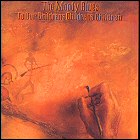 Possibly inspired by the moon shots of 1969, To Our Children’s Children’s Children is an interesting musical document of awe and wonder, and you can hear Hayward and Lodge turning over in their minds the implications of that decade-defining triumph of technology and determination. That rebirth of wonderment and subsequent wrestling with the realization that this triumph could be used for either good or ill is very much the theme of the album, starting with the cacophonous opening of “Higher And Higher”, evoking the sound of a rocket launch (or is that a bomb blast?) from up close and even featuring processed spoken vocals that could conceivably remind one of voices transmitted from space.
Possibly inspired by the moon shots of 1969, To Our Children’s Children’s Children is an interesting musical document of awe and wonder, and you can hear Hayward and Lodge turning over in their minds the implications of that decade-defining triumph of technology and determination. That rebirth of wonderment and subsequent wrestling with the realization that this triumph could be used for either good or ill is very much the theme of the album, starting with the cacophonous opening of “Higher And Higher”, evoking the sound of a rocket launch (or is that a bomb blast?) from up close and even featuring processed spoken vocals that could conceivably remind one of voices transmitted from space.
“Eyes Of A Child” furthers this theme by appearing twice on the album, in radically different forms. The first treatment is gentle and, sonically, appropriately childlike and quite relaxing. The second version is faster-paced, heavy with electric guitars, and filled with a somewhat more mature, one might even say rebellious, energy – and yet it’s the same song.. I thought that was a fascinating concept, and the Moodies did it just enough to avoid it being too repetitive. “I Never Thought I’d Live To Be A Hundred” and “I Never Thought I’d Live To Be A Million” provide another – somewhat opposite – set of matching bookends.
“Beyond” is a rousing instrumental with a dreamy, ethereal middle section, and leads directly into a quartet of some of the best material the Moodies ever put on record. “Out And In”, the churning “Gypsy”, and the wistful one-two punch of “Eternity Road” and “Candle Of Life” are a consecutive home run streak of winners. The album closes out with another winner, the gentle but eminently hummable “Watching And Waiting”.
 Overall, To Our Children’s Children’s Children is one of the Moody Blues’ best efforts, and one of the best reflections of a lyrical style that is uniquely theirs. Their words express concerns and worries about the human condition, present and future, without taking the banal (and, for future listeners lacking the context, commercially fatal) route of making things topical. Even knowing the events that were going on when these songs were written is entirely optional – it becomes a subtext, not a context vital to understanding the songs. Beautiful stuff – there simply isn’t enough music like this around.
Overall, To Our Children’s Children’s Children is one of the Moody Blues’ best efforts, and one of the best reflections of a lyrical style that is uniquely theirs. Their words express concerns and worries about the human condition, present and future, without taking the banal (and, for future listeners lacking the context, commercially fatal) route of making things topical. Even knowing the events that were going on when these songs were written is entirely optional – it becomes a subtext, not a context vital to understanding the songs. Beautiful stuff – there simply isn’t enough music like this around.
- Higher And Higher (4:11)
- Eyes Of A Child I (3:23)
- Floating (3:00)
- Eyes Of A Child II (1:22)
- I Never Thought I’d Live To Be A Hundred (1:05)
- Beyond (2:58)
- Out And In (3:41)
- Gypsy (3:33)
- Eternity Road (4:18)
- Candle Of Life (4:18)
- Sun Is Still Shining (3:36)
- I Never Thought I’d Live To Be A Million (0:33)
- Watching And Waiting (4:16)
Released by: Threshold / Polydor
Release date: 1970 / remastered & reissued 1997
Total running time: 40:20
Klark Kent – Kollected Works
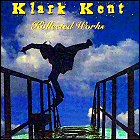 Even if you were unaware that Klark Kent is, in fact, a pseudonym for Stewart Copeland, it would be difficult to listen to Kollected Works without thinking of The Police. The heavy reggae/ska influence and experimental attitude so prevalent in The Police’s early work (and almost entirely excised by the time of Synchronicity) are found in spades here. Copeland founded the Police and was responsible for most of the early songwriting, until Sting’s prolific nature (and, let’s face it, greater overall songwriting skill) took over. These recordings date from that earlier time, with most of them seeing original release around 1978/9 as an outlet for Copeland, already feeling boxed in by the band.
Even if you were unaware that Klark Kent is, in fact, a pseudonym for Stewart Copeland, it would be difficult to listen to Kollected Works without thinking of The Police. The heavy reggae/ska influence and experimental attitude so prevalent in The Police’s early work (and almost entirely excised by the time of Synchronicity) are found in spades here. Copeland founded the Police and was responsible for most of the early songwriting, until Sting’s prolific nature (and, let’s face it, greater overall songwriting skill) took over. These recordings date from that earlier time, with most of them seeing original release around 1978/9 as an outlet for Copeland, already feeling boxed in by the band.
While the music itself has a lot in common with early Police, the lyrics really do take a different path. The more socially aware nature of the Police material gives way instead for the absurd or the downright silly. And even the production is more absurd, with voiceovers from a secretary pool and kazoos in the mix. If you’ve heard Police songs like “Any Other Day” (from Regatta de Blanc) you’ll be aware of Copeland’s, shall we say, unique vocal stylings. While I normally wouldn’t want an album full of Copeland vocals, the combination of vocals, lyrics and production on the Klark Kent material works.
If the songs have one failing in common, it’s that they lack polish. Most tend to just sort of peter out, rather than have any kind of proper ending. Just as Sting’s Police re-makes have lacked the depth of the original recordings, Copeland without Sting and Andy Summers feels somewhat shallow. But I’m a sucker for a one-man album, myself. For me, an interesting odyssey into original territory trumps careful, planned production any day.
 Ultimately, I think it goes without saying that if you’re a fan of Stewart Copeland or The Police (especially the more obscure tracks and B-sides) you need this album. Reggae and ska fans will find plenty to enjoy here as well, perhaps more than on any Police material. Also, if you enjoy experimental music-making, you should give Kollected Works a listen.
Ultimately, I think it goes without saying that if you’re a fan of Stewart Copeland or The Police (especially the more obscure tracks and B-sides) you need this album. Reggae and ska fans will find plenty to enjoy here as well, perhaps more than on any Police material. Also, if you enjoy experimental music-making, you should give Kollected Works a listen.
- Too Kool To Kalypso (2:28)
- Strange Things (2:42)
- Thrills (2:23)
- Excesses (3:02)
- Love Lessons (3:30)
- Office Girls (2:18)
- Away From Home (2:57)
- Don’t Care (2:10)
- Grandelinquent (3:10)
- My Old School (2:45)
- Ritch In A Ditch (2:29)
- Theme For A Kinetic Ritual (4:21)
- Stay Ready (3:03)
- Office Talk (6:50)
Guerilla (hidden track – 3:29)Released by: I.R.S.
Release date: 1995
Total running time: 48:08
Talking Heads – Little Creatures
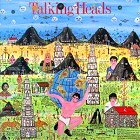 This Talking Heads album gets a bit of a bad rap for being the one where David Byrne took over the band’s creative direction completely, but be that as it may, it’s my favorite. Of course, just about any album that kicks off with “And She Was” would stand a good chance of ranking right up there with me – incredibly catchy, surreal and funny all at the same time. Which just about sums up this whole album.
This Talking Heads album gets a bit of a bad rap for being the one where David Byrne took over the band’s creative direction completely, but be that as it may, it’s my favorite. Of course, just about any album that kicks off with “And She Was” would stand a good chance of ranking right up there with me – incredibly catchy, surreal and funny all at the same time. Which just about sums up this whole album.
This is also the album with the single “Road To Nowhere” on it, bringing up the rear as the closing track, and yet sandwiched between those two minor hits are some of the Talking Heads’ best stuff.
But not all of it – “Give Me Back My Name” is just sorta so-so, an interesting lyric that seems like it should be supported by a more interesting melody. “Creatures Of Love” can catch you off guard with a bit of a country-ish sound, while “The Lady Don’t Mind” slips back into more of the typical Talking Heads sound.
Right smack in the middle of Little Creatures are two of my all-time favorites from this band: the obscure, not-quite-a-hit single “Perfect World” and “Stay Up Late”. “Perfect World” has one of my favorite Talking Heads melodies, and some of my favorite David Byrne vocals. Somewhat surprisingly, and yet not surprisingly, “Stay Up Late” has enjoyed something of a revival – with its cute lyric about keeping one’s baby brother up way past his bedtime, it’s guaranteed at least one spin per night in ABC’s overnight World News Now show. If “Stay Up Late” doesn’t inspire you to laugh out loud at least once, you’re listening to the wrong song.
“Walk It Down” is a song that opens with a deceptively odd, percussive sound that gives way to something more akin to an upbeat, joyous, almost churchy feel during the choruses. The catchy “Television Man” – another great Byrne vocal performance, by the way – stops just this side of being Jerzy Kosinski’s novel (and later film) Being There set to music. Now there’s a concept that would be worthy of David Byrne’s talents – not that anything wrong’s with “Television Man” as it is.
 I’ve heard a few diehard fans refer to Little Creatures as a bit of a post-sellout album for Byrne & company, but I have a hard time buying into that (miserable pun intended). Some of the band’s best and most offbeat stuff can be found here, though for this group, delving into more popular territory as this album did was offbeat. It’s rather uneven as an album when listened to all in one sitting, but there are indivdual numbers that make this easy to overlook. Little Creatures is a big joy to listen to.
I’ve heard a few diehard fans refer to Little Creatures as a bit of a post-sellout album for Byrne & company, but I have a hard time buying into that (miserable pun intended). Some of the band’s best and most offbeat stuff can be found here, though for this group, delving into more popular territory as this album did was offbeat. It’s rather uneven as an album when listened to all in one sitting, but there are indivdual numbers that make this easy to overlook. Little Creatures is a big joy to listen to.
- And She Was (3:39)
- Give Me Back My Name (3:22)
- Creatures Of Love (4:15)
- The Lady Don’t Mind (3:58)
- Perfect World (4:27)
- Stay Up Late (3:43)
- Walk It Down (4:44)
- Television Man (6:10)
- Road To Nowhere (4:19)
Released by: Sire
Release date: 1985
Total running time: 38:37
Christine McVie – In The Meantime
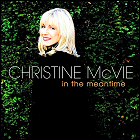 You’ll probably remember about a year ago when I was yammering on about my disappointment with Fleetwood Mac’s Say You Will, the first studio album in some 15 years with both Stevie Nicks and Lindsey Buckingham on board – but also the first studio album in many more years without Christine McVie. When I heard Friend, the first single from McVie’s first post-Mac solo album, I thought to myself “Ah, so that’s where the real Fleetwood Mac sound went – Christine took it with her!” After listening to the entire album from which that song springs, though, one wonders if that train of thought doesn’t run in both directions.
You’ll probably remember about a year ago when I was yammering on about my disappointment with Fleetwood Mac’s Say You Will, the first studio album in some 15 years with both Stevie Nicks and Lindsey Buckingham on board – but also the first studio album in many more years without Christine McVie. When I heard Friend, the first single from McVie’s first post-Mac solo album, I thought to myself “Ah, so that’s where the real Fleetwood Mac sound went – Christine took it with her!” After listening to the entire album from which that song springs, though, one wonders if that train of thought doesn’t run in both directions.
First off, let’s talk about what’s good on this album. Christine’s still got that voice, that husky voice that’s been sending shivers up and down my spine since I was young enough to have no business having those kind of shivers. Everything’s pretty much mid-tempo, pleasant adult-contemporary fare.
On the downside…everything’s pretty much mid-tempo, pleasant adult-contemporary fare. Christine gave us (or gave Fleetwood Mac) such songs as the rockin’ “Isn’t It Midnight” and the stately and beautiful “Songbird”. And she herself has had some knockout uptempo numbers like her best solo hit to date, “Got A Hold On Me”. When the only standouts from this collection I can think of are “Friend”, “Easy Come”, “Easy Go”, “Liar” and the just-about funky “Bad Journey”, maybe there’s a hint that a lot of the material on In The Meantime sounds very similar. There are few tracks that jump out and grab you, and arguably the song that has the best chance of doing that is right at the beginning of the album.
 Ultimately, it’s interesting. One could probably take a few select tracks from In The Meantime, put them back to back with a few select tracks from Say You Will, and almost have the makings of the best Fleetwood Mac album since Mirage. Numerous tracks on both albums hold their own as they are right now, but the magical interplay is missing, and both projects seem somehow diminished. That said, I’m willing to say that McVie solo is more cohesive than Mac minus McVie, and In The Meantime is on the lower end of my three-star range.
Ultimately, it’s interesting. One could probably take a few select tracks from In The Meantime, put them back to back with a few select tracks from Say You Will, and almost have the makings of the best Fleetwood Mac album since Mirage. Numerous tracks on both albums hold their own as they are right now, but the magical interplay is missing, and both projects seem somehow diminished. That said, I’m willing to say that McVie solo is more cohesive than Mac minus McVie, and In The Meantime is on the lower end of my three-star range.
- Friend (4:31)
- You Are (3:35)
- Northern Star (5:22)
- Bad Journey (4:29)
- Anything Is Possible (3:15)
- Calumny (4:55)
- So Sincere (3:40)
- Easy Come, Easy Go (4:32)
- Liar (3:53)
- Sweet Revenge (3:50)
- Forgiveness (3:45)
- Givin’ It Back (4:43)
Released by: Koch Records
Release date: 2004
Total running time: 50:33
Steve Winwood – About Time
 A long time ago, Steve Winwood was high on my list of favorite artists, back in the days when he was milking that Yamaha DX7 sound for all it was worth – and I loved it, frankly. I was a bit let down when he followed up great albums like Arc Of A Diver and Talking Back To The Night with a long period of silence, and then the mellowed-out Back In The High Life, and then another long hiatus after which he took a head-first plunge into low-tech rock with Roll With It. About Time is a minor letdown to the 80s Winwood fan in me, in that it continues along that path. In retrospect, and having learned a lot more about Winwood’s background since my teenage years, I realize that low-tech rock is what the man’s all about, and perhaps what he’s best at. And on that level, I can enjoy About Time quite a lot.
A long time ago, Steve Winwood was high on my list of favorite artists, back in the days when he was milking that Yamaha DX7 sound for all it was worth – and I loved it, frankly. I was a bit let down when he followed up great albums like Arc Of A Diver and Talking Back To The Night with a long period of silence, and then the mellowed-out Back In The High Life, and then another long hiatus after which he took a head-first plunge into low-tech rock with Roll With It. About Time is a minor letdown to the 80s Winwood fan in me, in that it continues along that path. In retrospect, and having learned a lot more about Winwood’s background since my teenage years, I realize that low-tech rock is what the man’s all about, and perhaps what he’s best at. And on that level, I can enjoy About Time quite a lot.
This time around, instead of trying to recapture his electric-organ-virtuoso Spencer Davis Group days, Steve Winwood is leaning on a sparser, bluesier sound. Every song on About Time sounds like a tune that evolved organically from a loose jam session – and generally, if you’re listening to something with a blues-based sound, that can’t help but be a good thing. And while synthesizers have come and gone out of fashion with him, Winwood still has a full command of his most powerful voice – he still has one of the most distinctive, effortless-sounding voices in rock music. He never sounds like he’s straining to hit a note, and he shows no sign of having written his material around a limited range.
“Cigano” is easily one of the album’s standout tracks, but the show-stealers here are two slow-bake numbers, “Silvia” and most especially “Horizon”, which is one of the best songs Winwood has ever done, hands-down. Now, one byproduct of the easy, bluesy style of most of About Time‘s tracks is that it can fade into the background a bit – even, I’ve found, if you’re listening on headphones. But those standout tracks (and your mileage may vary one which songs are the best on the CD) make it worthwhile. You’ll know which ones you like when you like ’em.
 It’s a good album, and it’s good to hear Steve Winwood getting back into the swing of things. I wouldn’t kick him in the shins for giving us a great pop song like he used to, but songs like “Horizon” are timeless and impossible to pigeonhole – and I’ll gladly take that too.
It’s a good album, and it’s good to hear Steve Winwood getting back into the swing of things. I wouldn’t kick him in the shins for giving us a great pop song like he used to, but songs like “Horizon” are timeless and impossible to pigeonhole – and I’ll gladly take that too.
- Different Light (6:36)
- Cigano (For The Gypsies) (6:21)
- Final Hour (5:36)
- Why Can’t We Live Together? (6:39)
- Domingo Morning (5:07)
- Now That You’re Alive (5:29)
- Bully (5:40)
- Phoenix Rising (7:27)
- Horizon (4:31)
- Walking On (4:55)
- Silvia (Who Is She?) (11:28)
Released by: Wincraft Music
Release date: 2003
Total running time: 69:51
William Shatner – Has Been
 In 1998, alt-pop rising star Ben Folds took a breather from the then-hugely-successful Ben Folds Five to cook up a side project, more for fun and experimentation than anything, called Fear Of Pop. Two tracks on that album were basically spoken-word poetry/rants set to music, with the poetry honors done by none other than William Shatner of Star Trek fame. Now, this doesn’t necessarily mean than Ben’s a dyed-in-the-wool Trekkie, but he has at least copped to an admiration for Shatner’s previous album of music/poetry, The Transformed Man. And lo and behold, enough mutual admiration emerged between Folds and Shatner to spark this little CD called Has Been.
In 1998, alt-pop rising star Ben Folds took a breather from the then-hugely-successful Ben Folds Five to cook up a side project, more for fun and experimentation than anything, called Fear Of Pop. Two tracks on that album were basically spoken-word poetry/rants set to music, with the poetry honors done by none other than William Shatner of Star Trek fame. Now, this doesn’t necessarily mean than Ben’s a dyed-in-the-wool Trekkie, but he has at least copped to an admiration for Shatner’s previous album of music/poetry, The Transformed Man. And lo and behold, enough mutual admiration emerged between Folds and Shatner to spark this little CD called Has Been.
And so help me, it’s kinda fun to listen to.
Fear Of Pop‘s “In Love” basically sets the mold for Has Been. Folds provides the musical accompaniment and does the bulk of the actual singing, while William Shatner lends his voice to a serious of monologues. The lyrics are purely Shatner’s, and the music is Folds’ in most cases. And it’s a better combination than you might at first expect. A lot of people are used to equating the Star Trek star with a galactic-scale ego. That includes me, by the way – I’ve read one of the guy’s autobiographies. But somehow he’s able to convey the inherent loneliness and pressure of his somewhat unique position in “It Hasn’t Happened Yet”, “Has Been” and “Real” (a dandy little collaboration with country artist Brad Paisley), and yet also gives full vent to things that bug him in a free-form rant with Henry Rollns, “I Can’t Get Behind That.”
But encroaching age and mortality are also very much in evidence on Has Been. “You’ll Have Time”, presented almost as a mock church sermon, talks about how there’s only so much time to live life but an eternity afterward to look back and regret the things that were never done. This Is Me Trying is a confessional from a man trying to reconcile with a bitterly estranged adult daughter before time runs out for both of them. And most haunting – some might say disturbing – of them all is “What Have You Done.” Not even weighing in at two-minutes, it’s an almost music-free piece in which Shatner relives the true story of coming home to find that his wife had drowned in the swimming pool. One almost has to hit stop after that track and sit back for a bit, maybe listen to something else a bit cheerier, before going on. It’s really a bit of a shock to the system.
 Overall, Has Been is startlingly effective as listening material. I wasn’t ready to, as Shatner and Rollins put it, “get behind that” conceptually until I heard it. It’s by no means perfect, and it’s not for everybody by any stretch, but William Shatner’s Has Been must be heard to be believed; Golden Throats, it’s not.
Overall, Has Been is startlingly effective as listening material. I wasn’t ready to, as Shatner and Rollins put it, “get behind that” conceptually until I heard it. It’s by no means perfect, and it’s not for everybody by any stretch, but William Shatner’s Has Been must be heard to be believed; Golden Throats, it’s not.

- Common People featuring Joe Jackson (4:38)
- It Hasn’t Happened Yet (3:52)
- You’ll Have Time (5:20)
- That’s Me Trying featuring Aimee Mann and Ben Folds (3:51)
- What Have You Done (1:49)
- Together featuring Lemon Jelly (5:41)
- Familiar Love (4:02)
- Ideal Woman (2:26)
- Has Been (2:21)
- I Can’t Get Behind That featuring Henry Rollins (3:02)
- Real featuring Brad Paisley (3:10)
Released by: Shout! Factory
Release date: 2004
Total running time: 40:12
Duran Duran – Astronaut
 Face it, nostalgia for the 80s is back in. Old arcade games are being repackaged in battery-powerered, self-contained joysticks and sold to us one more time. TV shows from over 20 years ago are hot commodities on DVD. And bands are rising from the ashes of the new wave movement that met its ignominious end with the rise of the hair band era.
Face it, nostalgia for the 80s is back in. Old arcade games are being repackaged in battery-powerered, self-contained joysticks and sold to us one more time. TV shows from over 20 years ago are hot commodities on DVD. And bands are rising from the ashes of the new wave movement that met its ignominious end with the rise of the hair band era.
Now, to be sure, I’m not sure Duran Duran was ever, strictly speaking, new wave. They took some of the new wave’s synth wizardry and production techniques and dropped a thick, frothy layer of funky guitar licks on top of it – not really a bad mixture, truth be told. You’d be hard-pressed to find too many consistently good 80s albums as Rio. And you’d be equally hard-pressed to find a band from that era making as solidly listenable a comeback as Astronaut, their new offering, and the first in quite some time with all five of Duran Duran’s founding members.
Part of the real shock value of Astronaut is that, while the band has updated its instrumental sound ever so slightly – okay, okay, quite a bit – the defining sound that is Simon Le Bon’s voice, and the great harmonies from the group as a whole, hasn’t changed a bit. If anything, I almost think his range has gotten better with age. On the instrumental side, the synth-heavy tunes show some real evolution from the band’s 80s sound, but it’s in the guitar-centered songs where you’re in for a real shock – quite a few times, we actually get acoustic guitar, and played really well too. Andy Taylor was never a slouch in the guitar department to begin with, mind you, but he really wows me here.
 Standouts include the damned catchy “Astronaut” with its euphoric synth sweeps and the well-chosen lead single “(Reach Up For The) Sunrise”, but those are just the two tracks that trip my trigger the most on the first listen – the whole album really is worth a listen. Who would’ve thought that Duran Duran could muster up a reasonable amount of musical credibility two decades down the road? Now the real trick is to see if they can stay together this time. If they can turn out more albums like this one, they have my permission.
Standouts include the damned catchy “Astronaut” with its euphoric synth sweeps and the well-chosen lead single “(Reach Up For The) Sunrise”, but those are just the two tracks that trip my trigger the most on the first listen – the whole album really is worth a listen. Who would’ve thought that Duran Duran could muster up a reasonable amount of musical credibility two decades down the road? Now the real trick is to see if they can stay together this time. If they can turn out more albums like this one, they have my permission.

- (Reach Up For The) Sunrise (3:29)
- Want You More! (3:43)
- What Happens Tomorrow (4:09)
- Astronaut (3:28)
- Bedroom Toys (3:55)
- Nice (3:30)
- Taste The Summer (3:57)
- Finest Hour (3:59)
- Chains (4:50)
- One Of Those Days (3:50)
- Point Of No Return (5:02)
- Still Breathing (5:59)
Released by: Sony / Epic
Release date: 2004
Total running time: 49:53
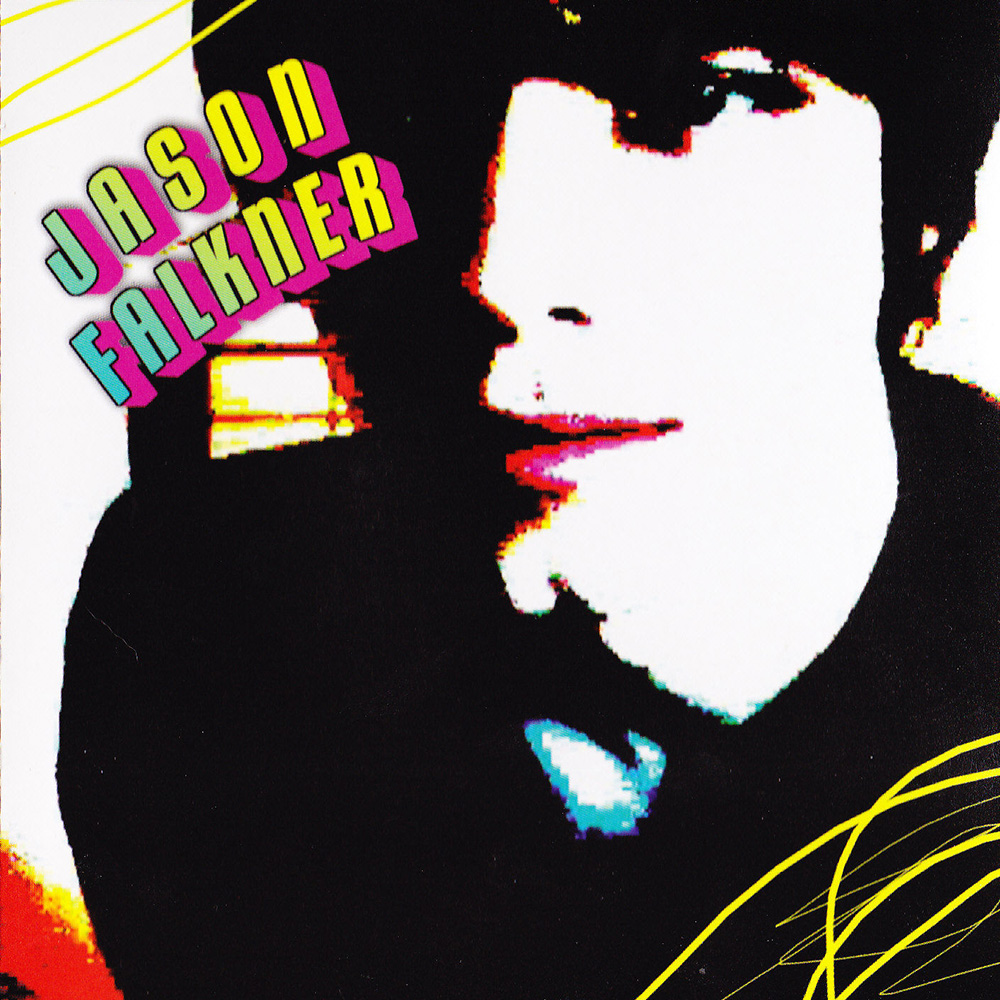
Jason Falkner – Bliss Descending
 It’s been far, far too long since we’ve heard anything new from Jason Falkner that wasn’t attached to a side project of some sort. Touring with his band TV Eye has taken up much of Falkner’s time the past few years, and he has done some interesting solo stuff along the way – Bedtime With The Beatles and a track on the Lynne Me Your Ears ELO/Jeff Lynne tribute collection, among other things. And there have been what seems like a half dozen releases of Falkner’s B-sides and demos along the way – all to cater to fans who are eagerly awaiting more solo work from the man himself. At long last, Bliss Descending brings us an all-too-brief taste of what Jason Falkner has been up to in his own studio.
It’s been far, far too long since we’ve heard anything new from Jason Falkner that wasn’t attached to a side project of some sort. Touring with his band TV Eye has taken up much of Falkner’s time the past few years, and he has done some interesting solo stuff along the way – Bedtime With The Beatles and a track on the Lynne Me Your Ears ELO/Jeff Lynne tribute collection, among other things. And there have been what seems like a half dozen releases of Falkner’s B-sides and demos along the way – all to cater to fans who are eagerly awaiting more solo work from the man himself. At long last, Bliss Descending brings us an all-too-brief taste of what Jason Falkner has been up to in his own studio.
Weighing in at only five songs, Bliss Descending is really surprisingly understated. Oddly enough, its standout track, the lively and very ELO-esque “Lost Myself” doesn’t hit until the end of the EP, and I had to go back and listen to the first four tracks all over again because that one song is so catchy, it immediately washes the others away. Not that they’re not good songs, but “Lost Myself” is that good – it’s the kind of tune that turns somewhat rational folks like me into fans rabid enough to pick up all of those demo/B-side collections, hoping for some lost gem like this one.
“The Neighbor” kicks things off strongly, but it has some fairly weak and repetitive lyrics; it’s a good song that needs a stronger set of words. “They Put Her In The Movies”, “Feeling No Pain” and “Moving Up” are decent songs, but, at the risk of making an unfair comparison, there’s nothing that really knocks the door down, walks in and makes you sit up and take notice on the order of “I Live” or “She Goes To Bed” or “Honey”. At least not until the last track, which stands up nicely alongside any of those.
 Still, I’m prepared to recommend this one to you, because a fair-to-middling Jason Falkner tune is better than quite a few artists’ best. If you’re wondering why I keep coming back to this guy’s work over and over again in theLogBook.com’s music review section, check out Bliss Descending – it’s an inexpensive gateway into Falkner’s other work, which also happens to rock.
Still, I’m prepared to recommend this one to you, because a fair-to-middling Jason Falkner tune is better than quite a few artists’ best. If you’re wondering why I keep coming back to this guy’s work over and over again in theLogBook.com’s music review section, check out Bliss Descending – it’s an inexpensive gateway into Falkner’s other work, which also happens to rock.

- The Neighbor (4:31)
- They Put Her In The Movies (3:44)
- Feeling No Pain (4:58)
- Moving Up (5:07)
- Lost Myself (4:01)
Released by: Wreckchord Records
Release date: 2004
Total running time: 22:27
Daniel Gannaway – Darling One Year
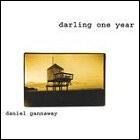 If you need evidence that there’s still a “wandering minstrel,” for lack of a better term, out there in the increasingly studio-bred world of music, allow me to present Daniel Gannaway as proof that the breed’s not extinct. The New Zealand-based musician logged studio time for his latest album in Ireland, Amsterdam, and NZ itself, all while working the road as a gigging musician. What has emerged from that work is Darling One Year, a tasty masterpiece of low-key mood that picks up the best stylistic experiments of his previous album and runs with them.
If you need evidence that there’s still a “wandering minstrel,” for lack of a better term, out there in the increasingly studio-bred world of music, allow me to present Daniel Gannaway as proof that the breed’s not extinct. The New Zealand-based musician logged studio time for his latest album in Ireland, Amsterdam, and NZ itself, all while working the road as a gigging musician. What has emerged from that work is Darling One Year, a tasty masterpiece of low-key mood that picks up the best stylistic experiments of his previous album and runs with them.
Of that previous album, I remember saying that Gannaway needed someone to hit the skins for him, and indeed on this outing he’s assembled a nice little group of fellow musicians to fill out the sound with some real live drums and bass. Gannaway’s voice, often processed and a bit ethereal, wafts over the proceedings – if anything, the best example on Bound & Suburban to which I could compare Darling One Year‘s vocals would be “Achilles”, where it sounded like the vocals were being driven through a flange pedal; in some cases on Darling One Year‘s heavier numbers, the vocals sound like they’re going through a guitar distortion pedal or some similar effect, and while the effects are never out of place with the songs, every once in a while it makes it a little hard to hear what’s actually being sung.
And that’s really my only quibble (and it’s a small one at that) with Darling One Year, because the lyrics are worth hearing – they’re often pointed and topical. The title track takes a first-person view of the oscurity of being an independent musician, and there’s no Bon Jovi waffle about riding a steel horse to be found here, but there’s no regret or bitterness to it either. “Student Debt Sucks” is funny and yet has a bubbling-just-under-a-boil rant going at the same time, with a great lyrical turn of phrase in “lending you astray.” Lyrically, the best song on here by miles is “Chain”, railing against bigotry and war and offering a philosophical comment about how every life is essentially a string of one-on-one encounters of one kind or another, any one of which could break said chain. “See The Light” offers a wry commentary on door-to-door evangelism (and here I thought that was a uniquely American phenomenon). And bookending things nicely, the last track, “A Small Thankyou”, is exactly as advertised.
 Darling One Year is some excellent music that, hopefully, can get a wider audience by word-of-mouth. Daniel Gannaway’s unique style of filtering folk influences through modern recording techniques makes for quite a compelling listen, and it certainly doesn’t hurt that he writes some damn good songs too. I’m pretty sure I said this about his previous release too, but I’ll repeat it here – if you only indulge in one independent release this year, Darling One Year would make a fine pick.
Darling One Year is some excellent music that, hopefully, can get a wider audience by word-of-mouth. Daniel Gannaway’s unique style of filtering folk influences through modern recording techniques makes for quite a compelling listen, and it certainly doesn’t hurt that he writes some damn good songs too. I’m pretty sure I said this about his previous release too, but I’ll repeat it here – if you only indulge in one independent release this year, Darling One Year would make a fine pick.

- Darling One Year (4:17)
- Student Debt Sucks (3:40)
- Julie (4:50)
- Gotta Drive (3:47)
- In The North Sea (4:44)
- Laughing Free (3:56)
- Chain (3:39)
- See The Light (4:26)
- Ecstasy Lovers (4:47)
- A Small Thankyou (3:21)
Released by: Daniel Gannaway
Release date: 2004
Total running time: 41:30
Brian Wilson – Smile
 I can’t possibly say something about the provenance and evolution of this album that hasn’t been said elsewhere, and I don’t have the musical knowledge to critique it professionally, so I won’t try. I will, however make a few observations from the perspective of a music lover.
I can’t possibly say something about the provenance and evolution of this album that hasn’t been said elsewhere, and I don’t have the musical knowledge to critique it professionally, so I won’t try. I will, however make a few observations from the perspective of a music lover.
When was the last time you heard an album that you just didn’t feel you could skip through? Smile is an album of pure Americana – very unfashionable, if not somewhat rude these days. But Smile neither sugar-coats nor apologizes for its theme. It’s not nostalgia.
“Rock, rock, roll Plymouth Rock roll over
Ribbon of concrete – just see what you done –
Done to the church of the American Indian!”
or
“Who ran the iron horse?
Have you seen the Grand Coulee workin’ on the railroad?”
Sentiments like these find easy perch among the America-basher subculture often found in hemp stores and the like, but that crowd will have a hard time embracing this album. Brian Wilson and Van Dyke Parks have created an album which embraces all of America – the good and the bad, the beautiful, the glorious, the oppressive, and the grim.
All of the songs are short. Of course the album was for the most part written in a time when singles had to be less than 3:30 to get airplay, but many of the pieces are around 2 minutes. And each piece is filled with changes in key, tempo, production sound, instrumentation, and even melody.
The song “Old Master Painter” is a solo cello introduction and single verse of “You Are My Sunshine” performed in a minor key through a vox box. At just over a minute in length, on any other album it would be a bridge piece. Here it’s a scene in a sprawling mural. This is a true concept album, and the bridges occur in the songs themselves.
Musical influences? They’re vast and varied. The entire album is sprinkled with the open harmonies which created the Beach Boys, but it would be more surprising if it weren’t. One note – if you’ve heard Brian Wilson in the last 20 years, you’ve noticed that his voice has thickened. I don’t know if the cause is drugs or just living. You can hear that thickness here. For that single reason, I think this album might have sounded better had it been recorded in 1966.
But listening to the album you hear Gershwin, Pink Floyd from the Syd Barrett days (there are some scary similarities to pieces like “Arnold Layne” and “See Emily Play”). Aaron Copland’s influence is apparent, but that’s almost a requisite for a musician toying with Americana.
There’s also a surreal relationship which is hard to keep straight. You can listen to “I’m In Great Shape” and hear orchestration reminiscent of Supertramp, then you remember he wrote this a decade or more before Roger Hodgson. “Vega-Tables” has elements which are pure They Might Be Giants, but again this actually predates TMBG by 30 years. Come to think of it, a lot of this sounds like TMBG, both in song structure and lyrics, to wit:
“I threw away my candy bar and I ate
The wrapper. And when they told me
What I did, I burst into laughter.”
This album could almost have been written by XTC, but Andy Partridge was barely out of diapers when it was written. And of course Partridge would be hard-pressed to write an album of Americana.
Lastly this album does one more thing that is perhaps unprecedented in pop music. It turns a song you’ve known your entire life into something completely different. “Good Vibrations” was always the final song of Smile, but we’ve come to know it as the single. As good a single as it is, when you listen to this album you come to realize the song was never complete. I can’t think of another example of something like this. The version here is not substantially different from the version you’ve known. That song was always supposed to be in this album, and once you hear it in this setting you’ll know it immediately.
 Who would have thought Van Dyke Parks would be back in the forefront of music in 2004? Probably not even him. Brian Wilson and Van Dyke deserve all the attention they’re receiving. They deserve the awards they’re destined to receive for this landmark work, and they deserve to be very proud of this remarkable contribution to American music.
Who would have thought Van Dyke Parks would be back in the forefront of music in 2004? Probably not even him. Brian Wilson and Van Dyke deserve all the attention they’re receiving. They deserve the awards they’re destined to receive for this landmark work, and they deserve to be very proud of this remarkable contribution to American music.

- Our Prayer / Gee (2:09)
- Heroes And Villains (4:50)
- Roll Plymouth Rock (3:48)
- Barnyard (0:58)
- Old Master Painter / You Are My Sunshine (1:03)
- Cabin Essence (3:31)
- Wonderful (2:06)
- Song For Children (2:16)
- Child Is Father Of The Man (2:18)
- Surf’s Up (4:08)
- I’m In Great Shape / I Wanna Be Around / Workshop (1:56)
- Vega-Tables (2:20)
- On A Holiday (2:36)
- Wind Chimes (2:52)
- Mrs. O’Leary’s Cow (2:27)
- In Blue Hawaii (2:59)
- Good Vibrations (4:36)
Released by: Nonesuch
Release date: 2004
Total running time: 46:55
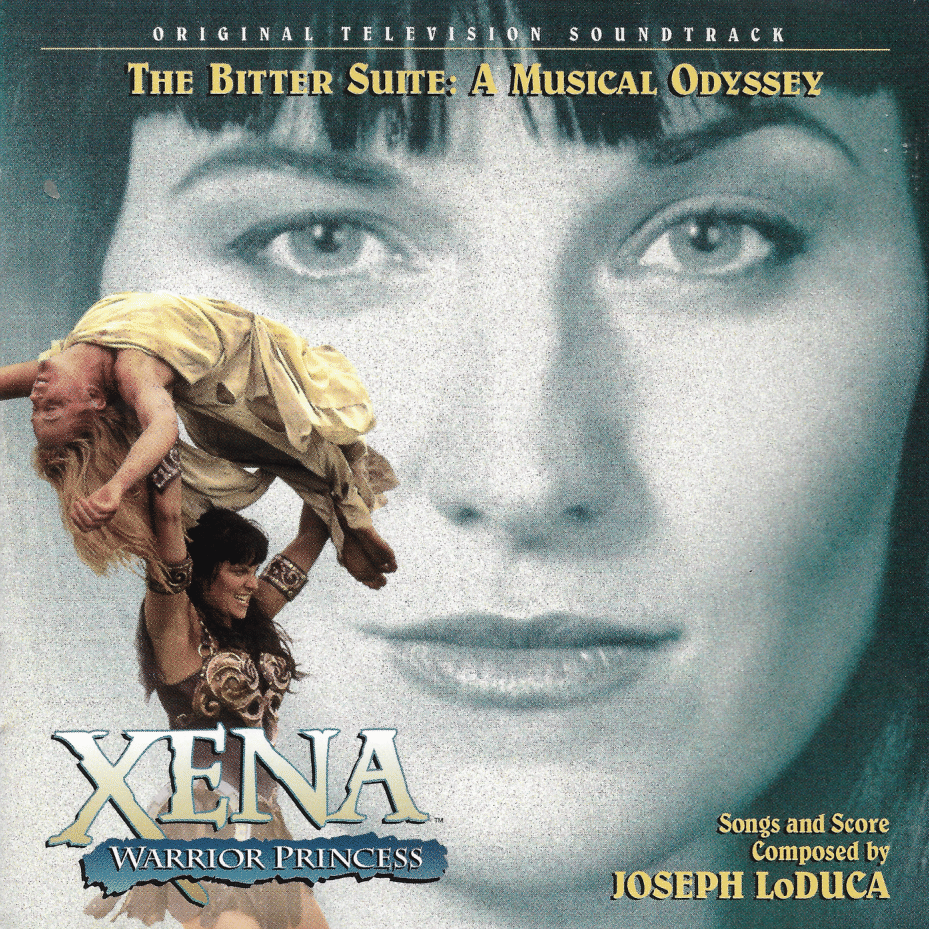
Xena: Warrior Princess – The Bitter Suite
 Everyone seems to have done a musical now, but Xena’s Bitter Suite was one of the first and, in terms of both story and music, still possibly the best. Joseph LoDuca’s music caters less to the series’ usual musical sensibilities, shifting instead into lavish big-screen-musical territory. There’s something almost Disney-esque about The Bitter Suite, but we’re talking old-school Disney – Pete’s Dragon and Bedknobs And Broomsticks Disney musical style, not this newfangled Every Male Lead Suddenly Sings Elton John Songs In Peabo Bryson’s Voice business that seems to pervade the lion’s share – pun pitifully intended – of Disney’s modern output.
Everyone seems to have done a musical now, but Xena’s Bitter Suite was one of the first and, in terms of both story and music, still possibly the best. Joseph LoDuca’s music caters less to the series’ usual musical sensibilities, shifting instead into lavish big-screen-musical territory. There’s something almost Disney-esque about The Bitter Suite, but we’re talking old-school Disney – Pete’s Dragon and Bedknobs And Broomsticks Disney musical style, not this newfangled Every Male Lead Suddenly Sings Elton John Songs In Peabo Bryson’s Voice business that seems to pervade the lion’s share – pun pitifully intended – of Disney’s modern output.
Even more gloriously, it’s refreshing to see that three of the story’s key players do their own singing. Renee O’Connor was dubbed by Susan Wood for her musical scenes, and Hudson Leick (Callisto) got to lip-synch to Michelle NiCastro’s vocals for her character. (NiCastro, incidentally, is a veteran of some of those newfangled Disney musicals. Small world, eh?) But Lucy Lawless, Ted “Joxer” Raimi and the late, great Kevin “Ares” Smith sang for themselves, thank you very much, and between my constant admiration for his performance as the god of war and the fact that he may be the best vocalist of the bunch, I’ve got to hand Kevin Smith some mad props here. From the slinky, seductive tones of “Melt Into Me” to his snide remark “ding dong, the bitch is dead!”, Smith comes out very much the unheralded star of this show. On TV, he also looked most at ease in this episode. Kevin, we lost you far, far too soon.
The CD as a whole is a collection of the musical numbers and highlights from the score (including the wildly percussive cues for the brutal opening sequences), with just enough dialogue to preserve something of the flow of the story. If there’s a single low point, it’s the slightly overwrought “Hearts Are Hurting”, a song divided into two parts during which Xena and Gabrielle work out a major conflict that had built up between the two characters since the beginning of the third season (of which the less said, the better, frankly). The vocals from both Susan Wood and Lucy Lawless are a bit strained, and the music stops just short of being risible – it’s actually the show’s theme song, slowed down a lot and with lyrics. Really the low point of both the CD and the  episode – and it should’ve been, could’ve been the high point.
episode – and it should’ve been, could’ve been the high point.
That aside, The Bitter Suite is outstanding, and the CD tells the story nicely – since it’s a musical, it’s almost the episode in audio form, and not much is left out except for some non-musical dialogue (the CD has roughly the same running time as the episode, in fact). Good stuff.
- The Sweat Hut / Slapped Out Of It / Xena’s In Town (4:42)
- Horrible Drag / On The Edge / Song Of The Fool (5:09)
- What’s Still Unwritten… (Song Of Illusia) / Little Ditties / Into The Chandra / Joxer The Mighty / Prepping Gabby (5:17)
- War And Peace / Gab Is Stabbed (5:52)
- Melt Into Me / Let Go (2:28)
- Dead? / Hearts Are Hurting (Part 1) (2:35)
- The Deliverer (4:07)
- Hate Is The Star (Song Of The Torment) / Hearts Are Hurting (Part 2) (5:42)
- The Way Out / The Love Of Your Love / Passing Through (7:10)
Released by: Varese Sarabande
Release date: 1998
Total running time: 42:55
Xena: Warrior Princess Volume 2
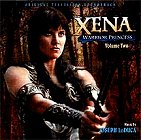 A few tracks into the second CD of music from Xena: Warrior Princess, one gets a general feeling of “westernization” on this album. No, not meaning that suddenly everything’s gotten to be like a guitar-twanging score from a Fellini western, but that the Mediterranean elements that so characterized the early scores are starting to be phased out in favor of a more traditional western/orchestral tone.
A few tracks into the second CD of music from Xena: Warrior Princess, one gets a general feeling of “westernization” on this album. No, not meaning that suddenly everything’s gotten to be like a guitar-twanging score from a Fellini western, but that the Mediterranean elements that so characterized the early scores are starting to be phased out in favor of a more traditional western/orchestral tone.
With the second season’s exploration of slightly less serious, campier territory than the first, little musical numbers began to creep in as well, though I’m happy to hear the “Joxer The Mighty” song here – Joxer remains my favorite character in the Herc/Xenaverse, and for God’s sake, someone build some surreal sitcom around Ted Raimi in a starring role now, it’ll be gold. But I digress. There are also grander vocal outings as well, with the operatic “Xena Kicks Bacchae Butt” and more understated “At Mother’s Tomb”. Suffice to say, season two’s overall tone is accurately reflected in this collection of music from that year.
With tracks 9 and 10, I find myself thinking primarily one thought: “Wow, Joe LoDuca listened to Peter Gabriel’s Passion somewhere between the first two seasons, didn’t he?” LoDuca (well, I think it’s LoDuca – see related notes in our recent review of the first volume of Xena music) throws in some modernization on the percussive end of things, reminding me of nothing so much as some of the more interesting (if anachronistic) tracks from the aforementioned album which gathered Gabriel’s soundtrack cues for The Last Temptation Of Christ. Not that this is altogether a bad thing, mind you.
 There’s also some seasonal fun with a healthy helping of music from A Solstice Carol, a Christmas-themed episode which made for some loving musical tips of the yuletide hat.
There’s also some seasonal fun with a healthy helping of music from A Solstice Carol, a Christmas-themed episode which made for some loving musical tips of the yuletide hat.
Overall, an interesting CD whose music is indicative of an overall shift in the “feel” of the series.
- Main Title (1:22)
- At Mother’s Tomb (3:00)
- Xena Kicks Bacchae Butt (2:03)
- Pop Goes Xena (1:11)
- Quicksand (1:25)
- Squeal (2:01)
- Sword Play (1:27)
- Homeland (3:29)
- Capoiera Fight (1:23)
- Many Winters Ago (2:17)
- Stowaway (1:53)
- You Really Believe That (1:05)
- Rrarr! (3:48)
- Friend (1:37)
- Crucifixion Of Xena / Up The Mountain (2:28)
- To The Rescue (1:42)
- Fighting Destiny (2:08)
- Talk With Solan (1:12)
- The Ballad of Joxer the Mighty (1:12)
- Solstice Night (2:13)
- The First Fate / Suspended Gabby (3:22)
- Where As Me / Gabby & Toys (2:20)
- More Fun And Games / Feather Fight (3:12)
- Hard Core Fishing (1:23)
- River Wild (1:37)
- Xena Is Bitten (1:33)
- Restoration (2:11)
- Caught In The Current (3:48)
- Callisto Becomes A God (2:04)
- Swamp Creatures / Imposter (2:40)
Released by: Varese Sarabande
Release date: 1997
Total running time: 67:03
Xena: Warrior Princess – music by Joseph LoDuca
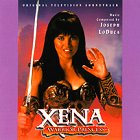 Spun off from the popular syndicated action series Hercules: The Legendary Journeys, Xena: Warrior Princess was – at least at first – an attempt to tell a somewhat more serious story in some of the same settings. Hercules and Xena might run into each other and share the odd adventure, but generally Xena would be up against not only mythical foes and malevolent gods, but her own dark side and just a little bit more angst per weekly episode than Hercules had to endure. Having already established a very Korngoldian style for Hercules, composer Joseph LoDuca (of whom more in a bit) decided to give Xena a somewhat different sound. The result is a very interesting soundtrack from the show’s first season.
Spun off from the popular syndicated action series Hercules: The Legendary Journeys, Xena: Warrior Princess was – at least at first – an attempt to tell a somewhat more serious story in some of the same settings. Hercules and Xena might run into each other and share the odd adventure, but generally Xena would be up against not only mythical foes and malevolent gods, but her own dark side and just a little bit more angst per weekly episode than Hercules had to endure. Having already established a very Korngoldian style for Hercules, composer Joseph LoDuca (of whom more in a bit) decided to give Xena a somewhat different sound. The result is a very interesting soundtrack from the show’s first season.
Though the Xena scores still wax bombastic at times in a style somewhere between Erich Wolfgang Korngold’s brassy, heraldic style and the Korngold-going-on-Wagner musical palette of John Williams, LoDuca applies an altogether more Mediterranean feel to the proceedings, complete with anguished female vocals and exotic instruments. The effect when seen against film is dramatic: it heightens the earthiness of the show’s equally exotic locations, and somehow it’s just easier to take the whole thing that much more seriously as a result. Highlights of the CD include “Soulmates”, “Xena and the Big Bird” (the musical cue for her later epic battle with the Cookie Monster was omitted for time), and from the pivotal episode Callisto, the best action music in the show’s entire history, “Ladder Fight”.
It’s that last cue which perhaps strikes the best balance between western and middle- eastern musical influences, with some awe-inspiring raging percussion keeping your pulse pounding (well, okay, my pulse at any rate, your mileage may vary), stings of both Korngold-style horns and Mediterranean instrumentation and vocals, and even some very interesting use of the Xena theme as leitmotif. Every fight scene for the rest of the show’s time on the air could’ve been tracked with this – it’s one of those pieces of music that’s just that hard to top.
I also have to offer some praise for the theme music – it too strikes a good balance between what would seem to be conflicting musical styles and sensibilities. The extended version of the theme that closes the album adds a little something extra that I don’t even recall hearing from the end credits, but the original arrangement is already strong enough – there’s a reason that this theme music was used, without any kind of amendments, for six years.
One final note: I’m uneasy who to attribute this album to; the cover art, as with the show, of course, credits everything to Joe LoDuca, who’s been collaborating with the Raimis on everything since Evil Dead. But more recent events have called that solitary composing credit into question: Dan Kolton, credited in the fine print here with “additional programming,” successfully sued for half of LoDuca’s performance  royalties on all of the music from Hercules and Xena, claiming that he had ghostwritten roughly half of the material without receiving credit (and therefore royalties). It doesn’t affect how the music sounds to me at all, mind you, but it’s a question of attribution that seems like it should be cleared up for the record.
royalties on all of the music from Hercules and Xena, claiming that he had ghostwritten roughly half of the material without receiving credit (and therefore royalties). It doesn’t affect how the music sounds to me at all, mind you, but it’s a question of attribution that seems like it should be cleared up for the record.
It’s still an excellent soundtrack, whoever is responsible for it.
- Main Title (1:15)
- The Warrior Princess (2:09)
- Darius (2:06)
- Soulmates (2:24)
- Burial (1:50)
- Xena And The Big Bird (2:27)
- Gabby Dance (1:00)
- The Gauntlet (1:38)
- Barn Blazers (2:21)
- Fight On The Heads (2:54)
- Draco’s Men (2:16)
- Glede Ma Glede (0:43)
- Burying The Past (2:59)
- Xena’s Web (2:12)
- Goodbye (2:49)
- Giants (2:37)
- Funeral Dance (1:35)
- Challenging The Gods (3:10)
- Dreamscape (3:01)
- Quarterman’s Festival (2:27)
- Roll In The Leaves (0:47)
- Funeral Pyre (1:24)
- On The Balcony (2:08)
- The Oracle (3:15)
- Hail Xena (1:35)
- Going To Kill Me (0:45)
- The Wrath Of Callisto (2:36)
- Bloodlust (2:25)
- Ladder Fight (4:44)
- Main Title (Extended Version) (1:22)
Released by: Varese Sarabande
Release date: 1996
Total running time: 65:54
R.E.M. – Around the Sun
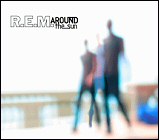 I’ve listened to Around the Sun at least a couple of times a day since the week before it came out, thanks to an online preview stream provided by REMhq.com. It’s lucky for you that I had that much lead time, or else you’d be reading one cranky review right now. This is a slow and subtle album, perhaps too much so for its own good, and there are a few songs that remain outright disappointments. But those repeated listenings have shown me that many of these songs are quite powerful in their simplicity and that Around the Sun is a worthwhile, although flawed, album.
I’ve listened to Around the Sun at least a couple of times a day since the week before it came out, thanks to an online preview stream provided by REMhq.com. It’s lucky for you that I had that much lead time, or else you’d be reading one cranky review right now. This is a slow and subtle album, perhaps too much so for its own good, and there are a few songs that remain outright disappointments. But those repeated listenings have shown me that many of these songs are quite powerful in their simplicity and that Around the Sun is a worthwhile, although flawed, album.
The opening track and first single, “Leaving New York,” is a midtempo track that blends Mike Mills’ piano and Peter Buck’s acoustic guitar to create what at first listen sounds like a straightforward, almost bland melody. But starting with the second verse, Michael Stipe’s vocals begin to layer and overlap, with each layer following a slightly different melody. The result pulls your attention in a number of directions at once, adding emotional urgency and creating the kind of disorientation that appears to be at the heart of the song. It’s a rather impressive accomplishment.
Unfortunately the album goes off the rails with the next song, “Electron Blue,” a repetitive electronics-tinged song that just doesn’t feel like it goes anywhere. “The Outsiders” features a rap by Q-tip as its third verse and is more effective at establishing a mood, but still doesn’t stand out. “Make It All Okay” is another piano-heavy ballad that has some potential, but for the first time I can remember, Stipe’s lyrics just aren’t up to snuff. It sometimes feels like he’s struggling just to fill out the melody with a lot of repeated words and pauses, such as the frequently used “It’s a long . . . long, long road . . . and I don’t know . . . which way . . . to go.” Stipe is usually able to use his melody and inflection to create a feeling such that the words don’t matter as much, but his performance on this track and in a couple of other places on the album just drew my attention to lyrics that seemed banal to me. It’s really a shame because this album does feature very effective use of Mills’ background vocals to create some effective moods.
That said, there are many places where he’s up to his usual standard. “Final Straw” is where the album begins to reassert itself. Written and initially released on REMhq.com in March 2003 as the invasion of Iraq began, this song combines direct lyrics and a calm, determined performance by Stipe with acoustic guitar and very well done synth/electronic elements to powerful, even haunting effect. I originally preferred the rough studio mix from 2003, but I’ve come to appreciate the album version. Towards the end there’s a high keyboard note in the background that gives the whole thing an almost choral feel; that note has a greater emphasis on the album track and I think that works.
The political tone carries through to the next song, “I Wanted to Be Wrong,” where Stipe says “I wanted to be wrong, but everyone was humming a song I don’t understand,” and “we can’t approach the Allies ’cause they seem a little peeved.” Outside of that last line, the political undercurrent that carries through the album is one you almost have to know to be looking for, because many of these songs could just as easily be about breakdowns in relationships or a more general feeling of social alienation. When you know the subtext, I do think it adds more power to the songs – but then I tend to agree with R.E.M.’s political stances more often than not, and your mileage may vary. Nowhere is this truer than the album’s final track, “Around the Sun” – the first R.E.M. song to be a title track. The song is used over the closing credits of Going Upriver, a movie about John Kerry’s experiences in Vietnam and as a protestor afterward. I don’t know whether or not the song was written about Kerry, but it’s hard for me not to think of him when I hear lines like “give me a voice so strong I can question what I have seen” and “hold on world ’cause you don’t know what’s coming, hold on world ’cause I’m not jumping off.”
 Thematically speaking, the album is very consistent, almost too much so. In addition to the tracks I’ve mentioned, “Boy in the Well” and “High Speed Train” are particularly subdued and contemplative tracks. It’s only on the jaunty “Wanderlust” and the uptempo acoustic number Aftermath that the album brightens up at all, and even these aren’t much of a change of pace. In its melancholy approach, Around the Sun has drawn a number of comparisons to Fables of the Reconstruction and Automatic for the People. But there’s nothing here like the loud, goofy fun of Fables’ “Cant Get There from Here” or Automatic‘s Sidewinder Sleeps Tonite to act as an escape valve. R.E.M. spent a long time recording this album, starting in early 2003, then taking a break for the tour anticipating their best-of album In View, and then returning to the studio this year to finish. In the process, they held off on some of the rockier songs they had been working on because they didn’t fit the feel of the album. I can’t help but wonder if they’d have been better served to just assemble the best collection of songs they could.
Thematically speaking, the album is very consistent, almost too much so. In addition to the tracks I’ve mentioned, “Boy in the Well” and “High Speed Train” are particularly subdued and contemplative tracks. It’s only on the jaunty “Wanderlust” and the uptempo acoustic number Aftermath that the album brightens up at all, and even these aren’t much of a change of pace. In its melancholy approach, Around the Sun has drawn a number of comparisons to Fables of the Reconstruction and Automatic for the People. But there’s nothing here like the loud, goofy fun of Fables’ “Cant Get There from Here” or Automatic‘s Sidewinder Sleeps Tonite to act as an escape valve. R.E.M. spent a long time recording this album, starting in early 2003, then taking a break for the tour anticipating their best-of album In View, and then returning to the studio this year to finish. In the process, they held off on some of the rockier songs they had been working on because they didn’t fit the feel of the album. I can’t help but wonder if they’d have been better served to just assemble the best collection of songs they could.
Around the Sun is not an album that immediately grabs you, but there’s a lot of very good work here. Like a lot of fans, I’m waiting for R.E.M. to break out of the slower mood they’ve explored in their three post-Bill Berry albums. But that doesn’t mean I’m going to ignore the good work that’s right in front of me. Truth be told, there’s a good chance this album might improve with age; my initial reaction to 1998’s Up was rather subdued, but it’s now one of my favorite albums. It wouldn’t surprise me if songs like “Final Straw” and “I Wanted to Be Wrong” earn Around the Sun a similar status in the future.
- Leaving New York (4:49)
- Electron Blue (4:12)
- The Outsiders (4:14)
- Make It All Okay (3:44)
- Final Straw (4:07)
- I Wanted to Be Wrong (4:35)
- Wanderlust (3:03)
- Boy in the Well (5:22)
- Aftermath (3:53)
- High Speed Train (5:03)
- The Worst Joke Ever (3:38)
- The Ascent of Man (4:07)
- Around the Sun (4:28)
Released by: Warner Bros.
Release date: 2004
Total running time: 55:21
R.E.M. – Reckoning
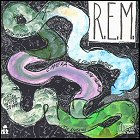 Having reached a somewhat surprising level of critical acclaim with their first album, R.E.M. knew it had to thread the needle for their follow-up, living up the expectations without turning out a rehash of their full-length debut. They chose to take a simpler approach, recording the album quickly and putting a slightly greater emphasis on a guitar-rock sound. Armed with such soon to be classics as “So. Central Rain” and “(Don’t Go Back to) Rockville,” Reckoning avoided any hint of a sophomore jinx and served to further build R.E.M.’s reputation.
Having reached a somewhat surprising level of critical acclaim with their first album, R.E.M. knew it had to thread the needle for their follow-up, living up the expectations without turning out a rehash of their full-length debut. They chose to take a simpler approach, recording the album quickly and putting a slightly greater emphasis on a guitar-rock sound. Armed with such soon to be classics as “So. Central Rain” and “(Don’t Go Back to) Rockville,” Reckoning avoided any hint of a sophomore jinx and served to further build R.E.M.’s reputation.
The rockers like “Harborcoat,” “Pretty Persuasion,” and “Rockville” are my favorites from the album. The latter, a country-tinged plea to a departing girl written by Mike Mills, has a nice veneer of “I don’t care that much” covering its “Oh yeah I really do care” core, and Michael Stipe does a fine job bringing both elements forth. The other two – well, I’m not sure what they’re about, per se, because this is Stipe at his least decipherable. But they’re fun songs, and the energy of Peter Buck’s guitars and Bill Berry’s drums shines through. Mills’ layered background vocals on “Harborcoat” really help carry that song along as well.
The slower songs are no slouches, either. I admit I can’t really listen to “Seven Chinese Brothers” without hearing “Voice of Harold” instead, but it’s still a fine song. (The two songs share the same backing track, but the latter has somewhat more unorthodox lyrics.) “Time After Time (Annelise)” is a rather somber song that demonstrates Buck’s chiming guitars at their most melancholy. Stipe shows off his voice’s emotional range in “So. Central Rain,” aiming for an air of detachment on the verses before delivering an almost pleading repeated “I’m sorry” for the chorus. First performed without a title on David Letterman’s show, “So. Central Rain” quickly became one of the band’s standout songs. In fact, it was the only track from Reckoning to receive its own video, in which Stipe sang the lyrics rather than lip sync. (The band also put together Left of Reckoning, a short film that used the LP’s first side as its soundtrack.)
 Reckoning is not an album I pull out of my CD collection for a full listen very often, but several of its tracks are standbys of my MP3 playlists. It’s a strong effort and a worthwhile milestone in R.E.M.’s development.
Reckoning is not an album I pull out of my CD collection for a full listen very often, but several of its tracks are standbys of my MP3 playlists. It’s a strong effort and a worthwhile milestone in R.E.M.’s development.
After R.E.M. achieved international success with Warner Bros., IRS Records re-released the band’s early catalogue overseas with additional tracks, mostly live performances and remixes along with the occasional b-side. These additional tracks remain unavailable on U.S. versions of the album.
- Harborcoat (3:51)
- Seven Chinese Brothers (4:15)
- So. Central Rain (3:11)
- Pretty Persuasion (3:53)
- Time After Time (Annelise) (3:59)
- Second Guessing (2:50)
- Letter Never Sent (2:57)
- Camera (5:21)
- (Don’t Go Back to) Rockville (4:34)
- Little America (2:56)
(Track listing reflects original U.S. release; foreign re-releases contain additional tracks)
Released by: IRS Records/A&M
Release date: 1984
Total running time: 38:11
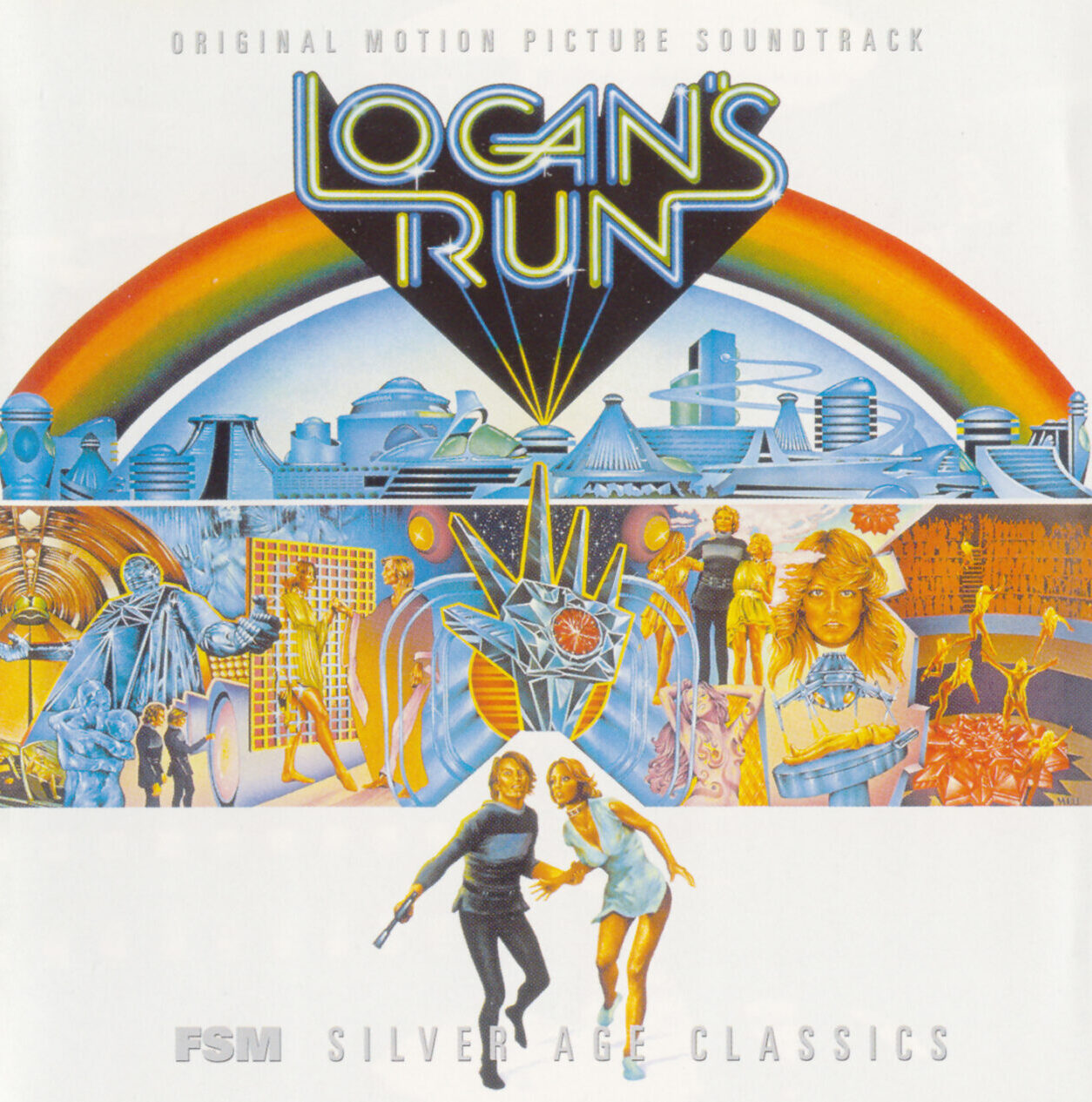
Logan’s Run – music by Jerry Goldsmith
Jerry Goldsmith’s music for Logan’s Run may prove to be just about the only element of the movie that had stood the test of time while still winning almost unanimous praise. Granted, I’m quite the fan of the movie itself, but it’s hard to deny that Goldsmith may have done a better job of painting the film’s emotional curve than the director did.
There are essentially two components to the score: a three-note theme for the futuristic city dome, and a more expansive melody for Logan’s burgeoning romance with Jessica. While the love theme may be more pleasant on a pure listening level, I find that it’s that city theme which I focus on, on an intellectual and structural level. Goldsmith puts those three notes through so many different permutations that it’s fascinating – in rapid-fire succession, the three notes form the electronic sound that opens the movie, as well as the orchestral figure that eventually overshadows it. But it’s also at the heart of the Carousel music, the nursery music, everything. Both structurally and musically, it’s pure genius.
Once the movie reaches its halfway point, the electronics disappear as Logan and Jessica leave the city behind and venture into the outside world. The city theme still follows them, though, now accompanying pursuing Sandman (and Logan’s former friend) Francis in the form of a low menacing orchestral reading of the same theme. But I’m getting ahead of myself a bit – the characters’ first glimpse of the outside world is treated with one of the most beautiful pieces of music Jerry Goldsmith ever wrote. It’s that good.
The complete score is heard here, in chronological order, including cues that were shortened or left out altogether due to trims that had to be made to reduce the movie’s nudity to a level where it would get a PG rating and not an R. Also included is a pop instrumental version of the love theme, though I was around when this movie first came out, and I certainly don’t recall hearing that hitting the radio airwaves at the time.
That’s the CD – but the CD is only half the package. This is the first disc I’ve bought from Film Score Monthly Magazine’s ever-growing selection of limited-edition soundtrack CDs, and as impressed as I’ve always been with the magazine itself, the CDs may well be even better. The detailed liner notes that accompany the CD do a fantastic job of putting the film and its music in context, and then goes through the score track-by-track, cue-by-cue, offering detailed analysis of each piece of music and its place in the complete score. Thematic elements and development, rhythm and structure are all analyzed in depth, but not to a degree that the layman can’t follow along. I was almost hesitant to offer any analysis of the score in this review at all, for fear that I’d wind up parroting the liner notes, but if anything, those notes helped draw my attention to the nuances in Goldsmith’s work all the more. If this is indicative of Film Score Monthly’s other CD offerings (and, judging by the fact that releases of other soundtracks such as The Omega Man and The Towering Inferno have already sold out, I’d guess that it is), I’ll be visiting their store more often and I heartily encourage you to do  the same.
the same.
In short, the music from Logan’s Run is a treat, and the added bonus material is a nice, deep dish of tasty, tasty gravy that heightened my enjoyment of the music quite a bit. Highly recommended!
- The Dome / The City / Nursery (3:05)
- Flameout (3:23)
- Fatal Games (2:26)
- On The Circuit (3:49)
- The Assignment / Lost Years (5:59)
- She’ll Do It / Let Me Help (2:41)
- Crazy Ideas (2:38)
- A Little Muscle (2:22)
- Terminated In Cathedral (1:28)
- Intensive Care (3:00)
- Love Shop (3:43)
- They’re Watching / Doc Is Dead (2:45)
- The Key / Box (4:22)
- Ice Sculpture (3:35)
- The Sun (2:15)
- The Monument (8:12)
- The Truth (2:03)
- You’re Renewed (2:58)
- The Journey Back / The Beach (1:36)
- Return To The City / Apprehensions (2:30)
- The Interrogation (3:58)
- End Of The City (2:23)
- Love Theme from Logan’s Run (2:27)
Released by: Film Score Monthly
Release date: 2001
Total running time: 74:18
R.E.M. – Fables of the Reconstruction
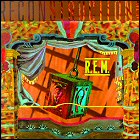 R.E.M. ventured into uncertain territory for its third studio album; having done all its previous releases with producer Mitch Easter relatively close to the band’s Athens home base, this time around the band flew to England to work with Joe Boyd. While producer and band had a decent working relationship and a healthy respect for each other, the four members were clearly out of their comfort zone, in a country where their indie-rock reputation had not yet spread, suffering through a cold and dreary winter quite unlike their usual climate, and unsure of where to take the next record musically. The result is Fables of the Reconstruction (or possibly Reconstruction of the Fables, since the phrase ‘of the’ appears twice on the album’s cover art), a murky, often melancholy album that’s probably the least accessible of their early work. Years later, drummer Bill Berry would tell Rolling Stone that “Fables sucked,” but behind the murk is a rewarding depth and songs that have become essential parts of the R.E.M. canon.
R.E.M. ventured into uncertain territory for its third studio album; having done all its previous releases with producer Mitch Easter relatively close to the band’s Athens home base, this time around the band flew to England to work with Joe Boyd. While producer and band had a decent working relationship and a healthy respect for each other, the four members were clearly out of their comfort zone, in a country where their indie-rock reputation had not yet spread, suffering through a cold and dreary winter quite unlike their usual climate, and unsure of where to take the next record musically. The result is Fables of the Reconstruction (or possibly Reconstruction of the Fables, since the phrase ‘of the’ appears twice on the album’s cover art), a murky, often melancholy album that’s probably the least accessible of their early work. Years later, drummer Bill Berry would tell Rolling Stone that “Fables sucked,” but behind the murk is a rewarding depth and songs that have become essential parts of the R.E.M. canon.
Peter Buck’s familiar chiming guitars pervade the album, but are often sent to the background as a foreboding atmospheric element. He provides plenty of more assertive lead guitar lines throughout, and Mike Mills steps up on bass to drive many of the songs like Kohoutek and Old Man Kensey (the latter song sharing a writing credit with J. Ayers). Buck, Mills and Berry mesh exceptionally well on “Life and How to Live It,” one of the rare up-tempo tracks on the album. Another, “Cant Get There from Here,” actually boasts a horn section at the end, one which screams “four white guys bringing on a tiny amount of the funk” in a lightly self-deprecating way – it’s a fun song, and one of the bright moments of the album.
 More typical is “Driver 8,” the album’s best-known song and one which really represents the essence of R.E.M. at the time. The album maintains a consistent mood thanks to the relatively slow pace of the songs and Michael Stipe’s delivery of lyrics that are still often highly allegorical or close to incomprehensible, although he starts making forays into social commentary with “Green Grow the Rushes.” The band’s isolation and homesickness comes through strongly in his singing and in the stories often drawn from the more eccentric side of the South. While not necessarily telling complete narratives, Stipe takes on more of the role of the storyteller here – stories that I feel more than I comprehend. If you’re willing to give Fables time to wash over you, you might feel them too.
More typical is “Driver 8,” the album’s best-known song and one which really represents the essence of R.E.M. at the time. The album maintains a consistent mood thanks to the relatively slow pace of the songs and Michael Stipe’s delivery of lyrics that are still often highly allegorical or close to incomprehensible, although he starts making forays into social commentary with “Green Grow the Rushes.” The band’s isolation and homesickness comes through strongly in his singing and in the stories often drawn from the more eccentric side of the South. While not necessarily telling complete narratives, Stipe takes on more of the role of the storyteller here – stories that I feel more than I comprehend. If you’re willing to give Fables time to wash over you, you might feel them too.
After R.E.M. achieved international success with Warner Bros., IRS Records re-released the band’s early catalogue overseas with additional tracks, mostly live performances and remixes along with the occasional b-side. These additional tracks remain unavailable on U.S. versions of the album.
- Feeling Gravitys Pull (4:48)
- Maps and Legends (3:01)
- Driver 8 (3:18)
- Life and How to Live It (4:20)
- Old Man Kensey (4:10)
- Cant Get There from Here (4:10)
- Green Grow the Rushes (3:42)
- Kohoutek (3:10)
- Auctioneer (Another Engine) (2:41)
- Good Advices (3:30)
- Wendell Gee (2:56)
(Track listing reflects original U.S. release; foreign re-releases contain additional tracks)
Released by: IRS Records/Capitol
Release date: 1985
Total running time: 39:43
R.E.M. – Lifes Rich Pageant
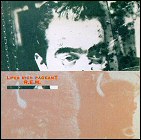 R.E.M. changed producers again for their fourth studio album, having been frustrated by the gloominess that pervaded the recording and songs of Fables of the Reconstruction. They turned to Don Gehman, who had recently had significant chart success with John Mellencamp, and brought a group of faster, more energetic songs to the studio. The band may not have really been ready to record again; they were so short of material that they had to dig into their archives, the outtake reel, and their repertoire of covers to amass 12 tracks that don’t even break the 40 minute barrier. The songs they did have were so strong, however, and Gehman’s fresh approach so helpful, that Lifes Rich Pageant ranks as my favorite album from the group’s IRS years.
R.E.M. changed producers again for their fourth studio album, having been frustrated by the gloominess that pervaded the recording and songs of Fables of the Reconstruction. They turned to Don Gehman, who had recently had significant chart success with John Mellencamp, and brought a group of faster, more energetic songs to the studio. The band may not have really been ready to record again; they were so short of material that they had to dig into their archives, the outtake reel, and their repertoire of covers to amass 12 tracks that don’t even break the 40 minute barrier. The songs they did have were so strong, however, and Gehman’s fresh approach so helpful, that Lifes Rich Pageant ranks as my favorite album from the group’s IRS years.
The opening track, the appropriately named “Begin the Begin,” clearly sets forth the album’s agenda with louder electric guitars from Peter Buck, enthusiastic drums from Bill Berry and clearer, more distinct vocals from Michael Stipe. (Clearer in the sense that you can figure out what words he’s singing. What those words might mean, on the other hand . . . not necessarily.) “These Days” has a very similar feel to it, while “I Believe” adds a banjo intro and Hyena has some nice piano work in the background to play off the guitars. “Just a Touch,” one of the band’s earliest songs, doesn’t sound out of place here; comparing the album version with a performance I’ve heard on a bootleg recording from the early 80s helps show Gehman’s influence as well as the growth in the group’s proficiency. All of these songs have a ‘can-do’ energy and confidence about them that’s reflected in the music and the lyrics, from “I Believe”‘s title to “These Days'” “We are hope despite the times” and “Begin the Begin”‘s “I looked for it and I found it, Miles Standish proud.”
It’s not all up-tempo all the time. “Fall on Me,” a song that started off as being a warning against acid rain and turned into a general plea against overwhelming pressure, and “Cuyahoga,” about the famed polluted river in Ohio, play up Mike Mills’ bass with a more somber pace. Both songs reflect the somewhat oblique political tone of Stipe’s work on this album, as does the beautifully sad “The Flowers of Guatemala.” Whatever Stipe is trying to get across with “Swan Swan H,” I never quite get it – but I get and enjoy its brooding atmosphere just fine.
The album closes out with “Superman,” a cover of an obscure 60s song by the Clique that features lead vocals by Mills. The cover’s actually gained a fair amount of notoriety over the years, and it’s a fun way to end the album. Both “Superman” and “Underneath the Bunker,” the brief outtake that closes the album’s first side, were added to the album so late that they were not listed on the album cover – which also does not list the other 10 tracks in the order they appear.
 Lifes Rich Pageant boasts a lot of strong material. The songs do have a lot of similarities to each other; the band seems to be focusing on variations on themes here, rather than explore a lot of different directions on one album. For me, the approach works – the songs flow together very well and make listening to the full album a very enjoyable experience. The short running time probably works in its favor here; 60 minutes of such variations might get tiresome, but 40 feel just right.
Lifes Rich Pageant boasts a lot of strong material. The songs do have a lot of similarities to each other; the band seems to be focusing on variations on themes here, rather than explore a lot of different directions on one album. For me, the approach works – the songs flow together very well and make listening to the full album a very enjoyable experience. The short running time probably works in its favor here; 60 minutes of such variations might get tiresome, but 40 feel just right.
After R.E.M. achieved international success with Warner Bros., IRS Records re-released the band’s early catalogue overseas with additional tracks, mostly live performances and remixes along with the occasional b-side. These additional tracks remain unavailable on U.S. versions of the album.
- Begin the Begin (3:28)
- These Days (3:24)
- Fall on Me (2:50)
- Cuyahoga (4:21)
- Hyena (2:51)
- Underneath the Bunker (1:27)
- The Flowers of Guatemala (3:56)
- I Believe (3:50)
- What If We Give It Away? (3:34)
- Just a Touch (3:00)
- Swan Swan H (2:50)
- Superman (2:52)
(Track listing reflects original U.S. release; foreign re-releases contain additional tracks)
Released by: IRS Records/Capitol
Release date: 1986
Total running time: 38:29
R.E.M. – Document
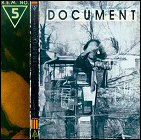 When Lifes Rich Pageant producer Don Gehman was unavailable to work with R.E.M. on a song they were contributing to a film soundtrack, he suggested they contact Scott Litt. Things went so well with that single that the band invited Litt to work with them on their fifth full studio album. The rest is, as they say, history, as Document marked R.E.M.’s first substantial entry into the mainstream.
When Lifes Rich Pageant producer Don Gehman was unavailable to work with R.E.M. on a song they were contributing to a film soundtrack, he suggested they contact Scott Litt. Things went so well with that single that the band invited Litt to work with them on their fifth full studio album. The rest is, as they say, history, as Document marked R.E.M.’s first substantial entry into the mainstream.
The song that broke into the Top 40 was “The One I Love;” it is now a rite of passage for R.E.M. fans to closely consider the lyric “A simple prop to occupy my time” and exclaim “It’s not a love song!” (Bonus points for making this remark upon seeing couples acting romantically to each other while watching the song in concert.) Making less of an impact at the time was “Its the End of the World As We Know It (and I Feel Fine),” a song whose rapid-fire stream of pop culture and other random references still inspires me to yell “Leonard Bernstein!” at the appropriate moment and has itself become ingrained in popular consciousness. (The song title is also the point at which the band’s practice of eschewing apostrophes most grates on my grammar-snob nerves, but I’ve almost gotten over it.)
Document is a much deeper album than its two best-known tracks, however. Many of its songs, like “Exhuming McCarthy” and “Welcome to the Occupation,” reflect the social activism that began to come to the fore in Lifes Rich Pageant. The former may be my favorite track from the album; it opens with the sound of Michael Stipe’s manual typewriter and slides from a jaunty march-like cadence to a mellower tone for Mike Mills’ declaration that “It’s a sign of the times” and back again. Bill Berry’s drums and Peter Buck’s electric guitar are prominent throughout the album, not quite at the built-for-the-arenas level of Green, but definitely going for a stronger rock feel than a lot of the band’s previous work. A good example of that approach is in the band’s cover of the Wire song “Strange,” which blends into the rest of the album rather well.
 Document tends to get moodier as it progresses; the shift can felt in the transition from “End of the World” to “One I Love,” and progresses from there to the horn-heavy “Fireplace.” The drum riff behind the wordless “ohhhhhh” chorus of “Lightnin’ Hopkins” sounds like a somewhat ominous call to action. Things slow down for “King of Birds,” which is a bit too lively to really be called a dirge, but which has a similar air of melancholy hanging over it. I think that song would have been a more effective closer than “Oddfellows Local 151,” which I think tends to meander a little too long.
Document tends to get moodier as it progresses; the shift can felt in the transition from “End of the World” to “One I Love,” and progresses from there to the horn-heavy “Fireplace.” The drum riff behind the wordless “ohhhhhh” chorus of “Lightnin’ Hopkins” sounds like a somewhat ominous call to action. Things slow down for “King of Birds,” which is a bit too lively to really be called a dirge, but which has a similar air of melancholy hanging over it. I think that song would have been a more effective closer than “Oddfellows Local 151,” which I think tends to meander a little too long.
After R.E.M. achieved international success with Warner Bros., IRS Records re-released the band’s early catalogue overseas with additional tracks, mostly live performances and remixes along with the occasional b-side. These additional tracks remain unavailable on U.S. versions of the album.
- Finest Worksong (3:48)
- Welcome to the Occupation (2:48)
- Exhuming McCarthy (3:19)
- Disturbance at the Heron House (3:33)
- Strange (2:32)
- Its the End of the World As We Know It (and I Feel Fine) (4:07)
- The One I Love (3:17)
- Fireplace (3:24)
- Lightnin’ Hopkins (3:18)
- King of Birds (4:07)
- Oddfellows Local 151 (5:21)
(Track listing reflects original U.S. release; foreign re-releases contain additional tracks)
Released by: IRS Records/Capitol
Release date: 1987
Total running time: 39:49
Frank Klepacki – Rocktronic
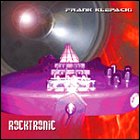 Frank K. is back in the house, and this time he’s kicking the doors down and knocking the walls flat. Unlike his solo debut Morphscape, Rocktronic is a little more similar stylistically from track one to track ten. And that’s cool – I loved some of Morphscape‘s more off-the-wall offerings like “Gonna Rock Yo Body” and “Cosmic Lounge”, but if Rocktronic proves anything, it’s that Frank Klepacki’s always got more musical ideas rattling around. And for those of us who learned about his music through his hard-driving accompaniment to some classic Westwood computer games (and I’d hazard a guess that this category probably includes almost everybody reading this), Rocktronic is homecoming week for you – it easily lives up to its name.
Frank K. is back in the house, and this time he’s kicking the doors down and knocking the walls flat. Unlike his solo debut Morphscape, Rocktronic is a little more similar stylistically from track one to track ten. And that’s cool – I loved some of Morphscape‘s more off-the-wall offerings like “Gonna Rock Yo Body” and “Cosmic Lounge”, but if Rocktronic proves anything, it’s that Frank Klepacki’s always got more musical ideas rattling around. And for those of us who learned about his music through his hard-driving accompaniment to some classic Westwood computer games (and I’d hazard a guess that this category probably includes almost everybody reading this), Rocktronic is homecoming week for you – it easily lives up to its name.
And the title should give you a pretty good clue of what to expect. Guitars are to the forefront of Rocktronic, and Klepacki demonstrates some impressive ability at that instrument. The opening volley, “Decible”, lives up to its name. The following track, “Rocktronic”, is probably the best fusion of rock and techno elements on the whole CD, with some mighty crunchy guitar work melding seamlessly with the techno elements. “Escape” feels a little bit like “Mode One” from Morphscape, only more aggressive and drum-driven, but the similarity is in some dandy throwback-to-the-’80s synth work. In Yo Face has both feet firmly in industrial/techno territory, and it’s best appreciated at a level where the speakers rumble the foundation of your house. Seriously. Headphones don’t quite do it justice.
“Take Me” has a very cool, laid back bluesy opening that leads into an extended hard rock jam on the same theme. There’s a nifty ’70s stadium rock guitar solo vibe to the whole thing. It Has Begun is more of an aggressive dance number, with the sampled voice yelling “It has begun!” Mortal Kombat-TV-ad-style hearkening back to some of Frank’s Command & Conquer work. “The Streets” and “In The Tunnel” almost sound like lost cuts from the Lexx music library, which isn’t a bad thing. The Streets has a little more of a Euro/electronica thing going, while “In The Tunnel” has the dramatic intensity of a soundtrack cue bubbling under the surface.
“Machines Collide” has an epic feel that hails back to some of the better Emperor: Battle For Dune tracks, with sampled choral textures and an interesting sonar-as-percussion element that I liked – it’s probably my favorite track on the CD, with “Take Me” running a close second. “Bring The Fight” closes things  out by jumping right back into hard rock territory, which brings us full circle.
out by jumping right back into hard rock territory, which brings us full circle.
On the one hand, I really missed the roller-coaster variety of styles that made Morphscape a lot of fun – but you can’t argue against Rocktronic‘s dominant style being the one that won Klepacki his fan base to begin with, and it’s still great music.
- Decible (4:32)
- Rocktronic (3:57)
- Escape (4:11)
- In Yo Face (3:42)
- Take Me (4:58)
- It Has Begun (4:06)
- The Streets (4:02)
- In The Tunnel (3:47)
- Machines Collide (4:42)
- Bring The Fight (4:28)
Released by: Frank Klepacki
Release date: 2004
Total running time: 42:27
Alan Parsons – A Valid Path
 Alan Parsons is back, that’s the good news. And the bad news? There really isn’t any. Parsons has jettisoned some of his “classic rock” sound and stepped firmly and unquestionably into the 21st century. The result is an album that will hopefully gain Parsons a whole new audience – and considering how much of his longtime fanbase was attracted to the sound of Parsons routinely going further out than the cutting edge 30 years ago, A Valid Path should also be a treat for the folks like me who’ve been hanging around since the 1970s.
Alan Parsons is back, that’s the good news. And the bad news? There really isn’t any. Parsons has jettisoned some of his “classic rock” sound and stepped firmly and unquestionably into the 21st century. The result is an album that will hopefully gain Parsons a whole new audience – and considering how much of his longtime fanbase was attracted to the sound of Parsons routinely going further out than the cutting edge 30 years ago, A Valid Path should also be a treat for the folks like me who’ve been hanging around since the 1970s.
And A Valid Path does surprise me in a few places. After those three decades hiding behind the mixing board or a variety of instruments or processing his vocals through a vocoder, Alan Parsons steps out into the limelight and takes a turn at a lead vocal with “We Play The Game”, and lo and behold, the guy’s got a hell of a voice, and it’s almost as smooth as former Alan Parsons Project cohort Eric Woolfson’s. Why he didn’t just come out and sing a long time ago is a mystery. If anything, it’s the one track that most solidly resembles classic Parsons.
There are other links to the past, too. But from the pre-release publicity going into this album’s release, it almost sounded like Parsons was decisively moving away from anything he’d done in the past, with this album’s focus on electronica. P.J. Olsson mixed most of the album, and lent a hand on several tracks, and there are guest appearances by Shpongle, The Crystal Method, Uberzone and Nortec Collective. Even more omipresent than Olsson is Parsons’ son Jeremy, who forges a couple of the albums’ strongest links to the past with from-the-ground-up remakes of classic Project tracks “Mammagamma” (as “Mammagamma ’04”) and the album-opening duo of “Dream Within A Dream” and “The Raven” from the very first Project album (as “A Recurring Dream Within A Dream”). The only people on the album that Parsons has worked with before are David Pack, who co-writes and provides heavily processed vocals on “You Can Run”, and Pink Floyd guitarist David Gilmour, giving a six-string assist to the opening track, “Return To Tunguska”.
That doesn’t mean that you won’t hear from folks you’re familiar with, though. Of all people, John Cleese briefly appears on the final track, “Chomolungma” (which is a rather obscure local name for Mount Everest, in case you’re wondering). This percussion-heavy track instantly earns a place in the pantheon of Parsons’ widescreen-ready instrumentals, and Cleese doesn’t even show up until nearly seven minutes into the not-quite-eight-minute track.
The much-publicized “electronica” angle can be a bit misleading, though. Olsson’s “More And More Lost Without You” is electronica, but it’s electronica with layers of twangy guitar on top of it. The instrumental “Tijuaniac” is surprisingly jazzy (though Parsons is no stranger to electronic-heavy jazz with such numbers as “Where’s The Walrus?” and “Urbania” in his back catalogue), and “L’Arc En Ciel” is thick with soaring guitar solos. Parsons may have cast off some of his classic-rock-radio-specific sounds, such as the 70s-style electric piano tones that he incorporated as recently as 1993’s post-Project comeback Try Anything Once, but he still brings a lot of the classic rock sensibility to the table, and hearing that together with a genre of music that seems to have an inherent youthfulness about it is an interesting step forward.
 Parsons once said in an interview that he’s always making music for today’s listeners, and A Valid Path certainly seems to back that up – but it also doesn’t have anything that’ll alienate long-time listeners who have appreciated Parsons’ constant walk along the cutting edge. Even if you’re chafing at the electronica label, give it a shot – it’s not as far removed from Parsons’ previous works as you might think, and it’s got some fantastic music on it.
Parsons once said in an interview that he’s always making music for today’s listeners, and A Valid Path certainly seems to back that up – but it also doesn’t have anything that’ll alienate long-time listeners who have appreciated Parsons’ constant walk along the cutting edge. Even if you’re chafing at the electronica label, give it a shot – it’s not as far removed from Parsons’ previous works as you might think, and it’s got some fantastic music on it.

- Return To Tunguska (8:49)
- More Lost Without You (3:21)
- Mammagamma ’04 (5:07)
- We Play The Game (5:35)
- Tijuaniac (5:30)
- L’Arc En Ciel (5:21)
- A Recurring Dream Within A Dream (4:12)
- You Can Run (3:53)
- Chomolungma (7:42)
Released by: Artemis
Release date: 2004
Total running time: 49:35
Finn Brothers – Everyone Is Here
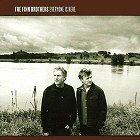 In the nine years since their first album hit the streets (and I was a bit of an early adopter too, snatching up an import copy months before a North American distribution deal was even hinted at), it seems I’ve had a bit of a hard time selling everyone on the merits of The Finn Brothers as an act unto themselves. And y’know, it wasn’t Crowded House’s Woodface, and it wasn’t Split Enz reborn, it was its own unique, rough-hewn entity. Even if you’d heard everything that either Tim or Neil Finn had done before, the original Finn Brothers album was not something that any of that had prepared you for.
In the nine years since their first album hit the streets (and I was a bit of an early adopter too, snatching up an import copy months before a North American distribution deal was even hinted at), it seems I’ve had a bit of a hard time selling everyone on the merits of The Finn Brothers as an act unto themselves. And y’know, it wasn’t Crowded House’s Woodface, and it wasn’t Split Enz reborn, it was its own unique, rough-hewn entity. Even if you’d heard everything that either Tim or Neil Finn had done before, the original Finn Brothers album was not something that any of that had prepared you for.
With Everyone Is Here, however, there’s a much more obvious polish to the whole thing – and in the finest tradition of the aforementioned gem of a Crowded House album, the whole thing was, for all intents and purposes, recorded twice over. Everyone Is Here was originally recorded in an upstate New York studio under the auspices of legendary producer Tony Visconti, but apparently the brothers changed their minds, scrapping everything except Visconti’s string arrangements on several songs and re-recording the lot with Mitchell Froom, who produced all but one Crowded House album, as well as Tim Finn’s third solo album and worked on Neil’s most recent solo outing, One Nil / One All.
The first single, “Won’t Give In”, is a radio-friendly mid-tempo affair heavy on Neil vocals, and it sets the tone for the album as a whole – hopeful, wistful, and concerned (not unlike the aforementioned Neil solo outing) with matters of home, hearth and heart. It’s catchy – but ultimately eclipsed by several other songs on the album when the whole thing is listened to in one sitting.
“Nothing Wrong With You” sports some of the best brotherly harmonies on the whole CD and a lush orchestral backing for what is, on the surface, a rather folky little number. “Anything Can Happen” is more of a thumping rocker, while “Luckiest Man Alive” comes closest to the loosely-arranged charms of the original Finn Brothers album – the harmony’s still there, but everything’s much looser, more like an off-the-cuff jam than the rest of the album.
If there’s anything that caught me off guard with Everyone Is Here, it’s that a number of the songs reminded me less of Crowded House and more of Split Enz. It seems to be primarily the songs driven by Tim Finn that do this, and “Homesick” may well be the Enziest song on the album, with the strings and vocals in the chorus strongly echoing the Judd-era Enz chestnut “Spellbound” – for all I know, with the song’s theme of returning home, Tim may have deliberately steered the song in that direction as a thematic element of coming full circle. It’s a great song on its own, with some dreamy harmonies in the chorus and soaring orchestral elements contrasting a series of raw and raucous verses.
“Disembodied Voices”, apparently the sole survivor of the original New York recording sessions with Tony Visconti, is a soft-pedaled folksy affair with mandolin and banjo – the latter played by Neil, an ability I’m not aware that he’d demonstrated before now. It’s an interesting little song, nicely produced, and leaves me wondering what happened that sent the Finns scrambling back to the safety net of Mitchell Froom.
“A Life Between Us” has the confident gait of a 50s rock ballad, and it’s primarily a Neil song – there’s not much evidence of Tim until halfway through the song, when a nice harmonic break reminding me a little of the bridge from the Crowded House song “Everything Is Good For You” brings both voices into play. “A Life Between Us” and “Disembodied Voices” also have slightly unusual lyrics – it’s rare for the Finns to pen lyrics that directly address their brotherly relationship, and even rarer for them to put two songs back-to-back that do that.
“All God’s Children” is a gleeful, distorted-guitar romp with another increasingly rare phenomenon – some classic throat-thrashing vocals from Tim. The next song is a shock to the system, chasing an unabashed rocker down the ornate ballad “Edible Flowers” (which many of us first heard on the Seven Worlds Collide concert DVD). I’d loved this song since that rather rough live performance hit my ears, and here the song comes into its own with a beautiful orchestral backing and a perfect vocal balance between Tim (in the verses) and Neil (in the absolutely soaring choruses). “Edible Flowers” may well be the best song on this whole album – everything just seems to click on this one.
A couple of Tim-heavy tunes, “All The Colours” and “Part Of Me, Part Of You”, bring back some really unusual chords and writing, and again on some intangible level they conjure up the Enz songwriting ethos in my mind. Part of me is thinking “well, duh, same vocalists, same songwriters, of course it sounds like the Enz,” but I still can’t shake the feeling that these are the Enziest songs that the Finns have turned out in ages. “Part Of Me, Part Of You” also bears a strong resemblance to a classic Crowdies tune – if you listen closely, the chords in the verses are almost the same as those in “Walking On The Spot”, only going much faster! That song also has a lyric – “we’ll still be here / when the cows come home” – which got a laugh out of me. I suppose it could be seen as trite, but compared the usual lyrical sophistication we get out of the Finns, it’s got shock value with a touch of humor.
 Tim and Neil both have a habit of ending albums on a slow but hopeful note (well, okay, maybe “Kiss The Road Of Rarotonga” doesn’t really bear that pattern out), and they do so again here with “Gentle Hum”, a song with a Neil lead vocal and a mostly hummed chorus. This song also has electronic percussion that, while it doesn’t really stick out enough to distract from the other instrumentation, seems slightly at odds with the rest of the song’s stripped-down, folky sound. That’s really venturing into nitpicking territory though – it’s a fine song, and a great one to go out on.
Tim and Neil both have a habit of ending albums on a slow but hopeful note (well, okay, maybe “Kiss The Road Of Rarotonga” doesn’t really bear that pattern out), and they do so again here with “Gentle Hum”, a song with a Neil lead vocal and a mostly hummed chorus. This song also has electronic percussion that, while it doesn’t really stick out enough to distract from the other instrumentation, seems slightly at odds with the rest of the song’s stripped-down, folky sound. That’s really venturing into nitpicking territory though – it’s a fine song, and a great one to go out on.
- Won’t Give In (4:21)
- Nothing Wrong With You (4:12)
- Anything Can Happen (3:05)
- Luckiest Man Alive (4:00)
- Homesick (3:50)
- Disembodied Voices (3:42)
- A Life Between Us (3:55)
- All God’s Children (3:49)
- Edible Flowers (4:53)
- All The Colours (2:13)
- Part Of Me, Part Of You (3:31)
- Gentle Hum (4:38)
Released by: Nettwerx (North America) / Parlophone (everywhere else)
Release date: 2004
Total running time: 46:14
R.E.M. – Green
 When R.E.M. set out to record Green, they knew it would be their first album for their new label, Warner Bros. They also knew that it would be the foundation of a worldwide arena tour designed to boost their global profile. It’s not surprising, then, that they produced a number of songs that refined the political rock songs of Document into an even more radio- and arena-friendly form. But if for no other reason than to keep themselves interested, they began experimenting with switching instruments and acoustic arrangements. The mix of silly pop songs and political introspection makes Green sometimes seem out of sorts, but it’s also not hard to see how the album helped take the band to a new level of popularity.
When R.E.M. set out to record Green, they knew it would be their first album for their new label, Warner Bros. They also knew that it would be the foundation of a worldwide arena tour designed to boost their global profile. It’s not surprising, then, that they produced a number of songs that refined the political rock songs of Document into an even more radio- and arena-friendly form. But if for no other reason than to keep themselves interested, they began experimenting with switching instruments and acoustic arrangements. The mix of silly pop songs and political introspection makes Green sometimes seem out of sorts, but it’s also not hard to see how the album helped take the band to a new level of popularity.
The first two songs, “Pop Song 89” and “Get Up,” definitely seem made for an arena rock show, more power pop than jangle pop. The songs feature strong melodies with simple, repetitive choruses and the occasional instrumental quirk, such as the dozen music boxes chiming in the middle of “Get Up.” The band uses the formula to perfection on the fourth track, “Stand,” whose goofy lyrics, guitar solo, video and associated dance made for a memorable presence on Top 40 radio at the time. (In fact, I can still remember where I was the first time I heard “Stand” on the radio – also the first time I had ever heard of R.E.M.)
Tracks 3, 5 and 6 show that Green is not all about fun and games. “You Are the Everything” features Bill Berry on bass, Mike Mills on accordion, and one of Peter Buck’s first experiments with mandolin. It’s a very spare, quiet song, one that literally opens with the sound of crickets chirping. It’s one of the things I like most about the song; it feels like you’re hearing each note and lyric on its own, as Stipe’s protagonist unburdens himself of his fears and imaginings. “World Leader Pretend,” meanwhile, is more complex in its arrangements, but features the same kind of introspection and mustering of resolve. There’s no mumbling from Stipe here; in fact, he felt so strongly about the lyrics to this song that they were printed on the liner notes, the only time that would happen until Up. “The Wrong Child” has a similar simplicity to “You Are the Everything,” but whereas the latter evokes the quiet beauty of nature, the former is a little more grating and discordant, befitting its lyrics; the song’s protagonist is a child with some kind of illness or physical problem that cuts him off from other children. Once upon a time, it was my least favorite song on the album, but it’s really grown on me over the years.
 The album heads back into rock territory with “Orange Crush,” but there’s far more edge and intensity to this song than the shinier pop songs that opened the album. The band’s rhythm section does a nice job of giving this song, whose lyrics evoke the specter of Agent Orange and the psychological and environmental legacies of war, a sense of marching forward into whatever the fates have in store. Even fifteen years later, this song packs a heck of a punch in the band’s live show. The album slows down again for the final three listed tracks, although only “Hairshirt” has the same kind of acoustic sensibility as “You Are the Everything” and “The Wrong Child.”
The album heads back into rock territory with “Orange Crush,” but there’s far more edge and intensity to this song than the shinier pop songs that opened the album. The band’s rhythm section does a nice job of giving this song, whose lyrics evoke the specter of Agent Orange and the psychological and environmental legacies of war, a sense of marching forward into whatever the fates have in store. Even fifteen years later, this song packs a heck of a punch in the band’s live show. The album slows down again for the final three listed tracks, although only “Hairshirt” has the same kind of acoustic sensibility as “You Are the Everything” and “The Wrong Child.”
There is also an eleventh untitled track, which features Buck on drums – Berry claimed the drum part Buck had written was so full of mistakes that he’d be unable to perfectly replicate them for an entire song. It’s a great closing track, and Berry’s fears notwithstanding, I even think the drum part’s kinda nifty.
- Pop Song 89 (3:03)
- Pop Song 89 (3:03)
- Get Up (2:35)
- You Are the Everything (3:45)
- Stand (3:10)
- World Leader Pretend (4:15)
- The Wrong Child (3:35)
- Orange Crush (3:50)
- Turn You Inside-Out (4:15)
- Hairshirt (3:55)
- I Remember California (5:05)
- Untitled (3:15)
Released by: Warner Bros.
Release date: 1988
Total running time: 41:00
R.E.M. – Out of Time
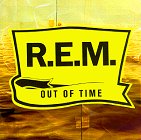 I first heard “Losing My Religion” on a Top 40 radio station shortly after its release. I thought it was an OK song, but nothing special. I was clearly in the minority in that view, as the single and video became hugely popular. Eventually I borrowed a copy of Out of Time from a friend, and I’ve been an R.E.M. fan ever since. The album, the band’s best-selling in the United States, is full of beautiful songs that highlight R.E.M.’s eagerness to challenge conventions and shake up its own status quo.
I first heard “Losing My Religion” on a Top 40 radio station shortly after its release. I thought it was an OK song, but nothing special. I was clearly in the minority in that view, as the single and video became hugely popular. Eventually I borrowed a copy of Out of Time from a friend, and I’ve been an R.E.M. fan ever since. The album, the band’s best-selling in the United States, is full of beautiful songs that highlight R.E.M.’s eagerness to challenge conventions and shake up its own status quo.
After turning out pretty much an album a year throughout the 80s, Bill Berry, Peter Buck, Mike Mills and Michael Stipe slowed down for the writing of Out of Time. They often switched instruments; Berry, for example, wrote most of the bass lines while Mills worked heavily with pianos and keyboards. They brought in unusual instrumentation, like the harpsichord on “Half a World Away,” and guest vocalists like the B-52s’ Kate Pearson (on “Shiny Happy People” and “Me In Honey”) and KRS-One (on “Radio Song”). Mike Mills sang lead vocals on not one but two songs, “Near Wild Heaven” and “Texarkana.” (I love Mills’ work, but I think he’s better suited for support and backup vocals. He does do a nice job on “Texarkana,” whose lyrics he wrote when Stipe found himself unable to come up with anything for the song.) Stipe decided to personalize his lyrics; he described Out of Time as an album full of love songs, after having heavily mined political territory on the band’s previous three albums. The ornate arrangements work very well; Buck described the band as “rock and roll band that plays sitting down” in this time period, and it’s a very apt description.
 While “Losing My Religion” has certainly grown on me over the years, it’s still not my favorite song on the album. I prefer “Radio Song,” “Me in Honey,” and “Half a World Away.” In none of those songs am I very confident about what Stipe is trying to say, although I think the emotion of his vocal performance more than makes up for the ambiguity of his lyrics. Musically, the first two are among the faster-paced, clearly-rock songs on the album, while the latter’s harpsichord makes it the most frequently cited example of the album’s “baroque” influence. Slower songs like “Low” and “Endgame” have to strike me in the right frame of mind; they have the potential to simply come off as depressing, but in the right context they’re both meditative and cathartic. The mournful “Country Feedback” has become quite popular amongst the band’s fan base; in fact, it was the most requested song of the band’s 2003 tour.
While “Losing My Religion” has certainly grown on me over the years, it’s still not my favorite song on the album. I prefer “Radio Song,” “Me in Honey,” and “Half a World Away.” In none of those songs am I very confident about what Stipe is trying to say, although I think the emotion of his vocal performance more than makes up for the ambiguity of his lyrics. Musically, the first two are among the faster-paced, clearly-rock songs on the album, while the latter’s harpsichord makes it the most frequently cited example of the album’s “baroque” influence. Slower songs like “Low” and “Endgame” have to strike me in the right frame of mind; they have the potential to simply come off as depressing, but in the right context they’re both meditative and cathartic. The mournful “Country Feedback” has become quite popular amongst the band’s fan base; in fact, it was the most requested song of the band’s 2003 tour.
- Radio Song (4:12)
- Losing My Relgion (4:26)
- Low (4:55)
- Near Wild Heaven (3:17)
- Endgame (3:48)
- Shiny Happy People (3:44)
- Belong (4:03)
- Half a World Away (3:26)
- Texarkana (3:36)
- Country Feedback (4:07)
- Me In Honey (4:06)
Released by: Warner Bros.
Release date: 1991
Total running time: 44:10
R.E.M. – Automatic for the People
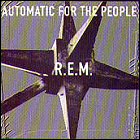 Many critics and fans consider Automatic for the People to be R.E.M.’s finest hour. They’ll get no argument from me. Transformed into superstars by Out of Time, with millions waiting to see what they’d do for a follow-up, the band produced a complex, contemplative, and absolutely beautiful album.
Many critics and fans consider Automatic for the People to be R.E.M.’s finest hour. They’ll get no argument from me. Transformed into superstars by Out of Time, with millions waiting to see what they’d do for a follow-up, the band produced a complex, contemplative, and absolutely beautiful album.
Lyrically, the most frequent theme is death and loss. “Try Not to Breathe”‘s protagonist is an elderly woman contemplating her full life and how she wants to be remembered; “Sweetness Follows” is about the coming together of a family at a funeral. In “Monty Got a Raw Deal” and “Man on the Moon,” Michael Stipe considers long gone cultural figures such as Montgomery Clift and Andy Kaufman. Amid all this melancholy is a core of hope, optimism, and belief in the human spirit. There’s the urge to “hold on” in “Everybody Hurts,” one of the most direct songs Stipe has ever written, and another entreaty in “Sweetness Follows” to “live your life filled with joy and thunder.” There’s also the goofiness of “The Sidewinder Sleeps Tonite,” which includes Stipe’s laughter over his mispronunciation of Dr. Seuss. The lyrics themselves are good, but what makes the songs great is Stipe’s emotional range, the way he can make a particular feeling almost tangible without having to overpower the music or the listener. I don’t think he’s ever been better as a performer than he is on this album.
It helps that he has such strong musical backing. While Bill Berry, Peter Buck and Mike Mills went into the studio expecting to do a harder rock record, they instead found themselves drawn to slower, more complex, often heavily acoustic arrangements. John Paul Jones added orchestral arrangements to four songs, including “Nightswimming,” which may well be my favorite song in the universe. The orchestral elements support Mike Mills’ beautiful piano melody, which perfectly fits Stipe’s reflections on the carefree spirit of youth. Mills also wrote the album closer, “Find the River,” which is quite possibly the best final track I know of. This time Mills’ keyboards balance with Peter Buck’s acoustic guitar and Stipe’s vocal to create a palpable sense of finality, a moment of looking back that’s calm yet intense because it sums up what’s gone before.
Buck and Bill Berry also contribute standout tracks to the album; “Everybody Hurts,” for example, was penned by Berry, while Buck contributed “Drive” and “Try Not to Breathe.” Buck’s songs in particular seem to hold a little more edge, a tinge of dark and ominous things on the horizon, but they’re still wonderfully constructed pieces of music. Outside of the peppy “Sidewinder” and the electric-guitar-driven “Ignoreland” (and maybe the choruses to “Man on the Moon”) this is generally a slow album, and while some have criticized those two songs for throwing off the album’s unified feel, I think both work well as interludes that try and cover similar themes from different vantage point, giving the album a little bit of variety to help individual tracks stand out.
 Automatic was recently released in DVD-Audio format, featuring new mixes for both stereo and 5.1 channel surround sound. These mixes certainly allow the listener to hear more detail; there are certain instrumental flourishes as well as a line or two of vocals that I had not been aware of before the DVD. Some may find the tweaks a bit distracting, especially in the surround sound mix. It’s also a neat listening experience that gives some sense of the role mixing and production play on an album. The DVD-A also comes with images of Stipe’s handwritten and hand-typed lyric sheets, a short electronic press kit documentary on the making of the album and the restaurant that inspired its title, a photo gallery, and an extended set of liner notes. Since DVD-A players are not that common, I’d only recommend this version for the really hardcore fan.
Automatic was recently released in DVD-Audio format, featuring new mixes for both stereo and 5.1 channel surround sound. These mixes certainly allow the listener to hear more detail; there are certain instrumental flourishes as well as a line or two of vocals that I had not been aware of before the DVD. Some may find the tweaks a bit distracting, especially in the surround sound mix. It’s also a neat listening experience that gives some sense of the role mixing and production play on an album. The DVD-A also comes with images of Stipe’s handwritten and hand-typed lyric sheets, a short electronic press kit documentary on the making of the album and the restaurant that inspired its title, a photo gallery, and an extended set of liner notes. Since DVD-A players are not that common, I’d only recommend this version for the really hardcore fan.
This album is an outstanding piece of work, and the only reason I’m rating it a 4 is that Earl’s rating system won’t let me give it a 5.
- Drive (4:31)
- Try Not to Breathe (3:50)
- The Sidewinder Sleeps Tonite (4:09)
- Everybody Hurts (5:20)
- New Orleans Instrumental No. 1 (2:15)
- Sweetness Follows (4:21)
- Monty Got a Raw Deal (3:17)
- Ignoreland (4:27)
- Star Me Kitten (3:16)
- Man on the Moon (5:14)
- Nightswimming (4:18)
- Find the River (3:49)
Released by: Warner Bros.
Release date: 1992
Total running time: 48:52
R.E.M. – New Adventures in Hi-Fi
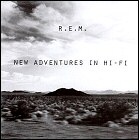 It was clear during the recording of New Adventures in Hi-Fi that an era of R.E.M. history was coming to a close. The band’s tenth studio album was their fifth and final record of their initial contract with Warner Bros.; their relationship with longtime manager Jefferson Holt was deteriorating; and perhaps most importantly (at the time), longtime collaborator Scott Litt had announced that this would be his last time in the producer’s chair. The biggest milestone, however, was only clear in retrospect. A year after the album’s release, drummer Bill Berry retired, making New Adventures the last album written and performed by the original lineup of Berry, Peter Buck, Mike Mills and Michael Stipe. Fortunately, they turned out one of their finest efforts, a stirring album that serves to highlight the band’s diversity.
It was clear during the recording of New Adventures in Hi-Fi that an era of R.E.M. history was coming to a close. The band’s tenth studio album was their fifth and final record of their initial contract with Warner Bros.; their relationship with longtime manager Jefferson Holt was deteriorating; and perhaps most importantly (at the time), longtime collaborator Scott Litt had announced that this would be his last time in the producer’s chair. The biggest milestone, however, was only clear in retrospect. A year after the album’s release, drummer Bill Berry retired, making New Adventures the last album written and performed by the original lineup of Berry, Peter Buck, Mike Mills and Michael Stipe. Fortunately, they turned out one of their finest efforts, a stirring album that serves to highlight the band’s diversity.
While not exactly a “road record,” a sense of travel and searching does fill the album. Several of the songs were written and recorded during soundchecks and performances on the 1995 Monster tour and have its hard guitar/feedback-heavy sound. “Binky the Doormat,” “Departure,” “Undertow,” and “The Wake-Up Bomb” had in fact all worked their way into the setlist by the end of the tour, and the album versions do a good job of capturing the energy of the live performances. My favorite song, “Leave,” was recorded during a soundcheck in Atlanta. The seven-minute track opens with an acoustic guitar intro by Berry, then kicks into gear with a siren-like feedback trail produced by backup musician Scott McCaughey holding a single key on an old Arp Odyssey keyboard and moving the octave switch back and forth – a wrist-numbing effort that meant the band could only rehearse the song on alternating days. The effort certainly paid off – the keyboard wail pushes the song along without overwhelming the other keyboards and guitar work. There’s a sense of overwhelming pressure, and Stipe’s vocals play off the music to convey the desperate desire to escape that weight. (Stipe himself said he wasn’t pleased with his performance on this song, and later re-recorded it for a much shorter and far less intense version. So go figure.)
After the tour, the band reworked some of the live tracks in the studio, bringing some of the complexity and production techniques that marked the band’s two biggest albums to the more energetic rock songs. Bittersweet Me, for example, benefits from additional keyboards from Mills supporting some fine Buck guitar work. The song mines some of the same thematic territory as “Leave” – I can feel the longing in the bridge thanks to Stipe and Mills’ vocals – but the brisker tempo also cuts the edge a little bit and makes the song almost wistful. “Be Mine,” an almost-but-not-quite power ballad, was originally demoed on a tour bus but was re-recorded in the studio, keeping only a bit of driver chatter as an intro. The almost-but-not-quite was a deliberate choice by the band, and I think it works well. At first listen, it sounds like a surprisingly sweet love song from Stipe – but as he’s pointed out in interviews, the lyrics are totally centered on the narrator’s desires, bringing an undercurrent of selfishness to the mix.
Several new songs were also added during the studio process. One of them, “E-Bow the Letter,” features guest vocals by Patti Smith, a shared musical idol of Buck and Stipe. The band insisted on making this “folk rock dirge” the album’s lead single – which was such a disastrous choice that the band started leaving such decisions up to the record label. It’s far from my favorite song on the album, and even in the grunge/alternative days of 1996, it wasn’t hugely radio-friendly. In the context of the album, though, it works. More successful is “New Test Leper,” one of a handful of songs that hearken to the more acoustic sound of Out of Time and Automatic for the People. The combination of Mills on organ and Buck on acoustic guitar makes the song almost float as Stipe plays the part of a tabloid talk show guest irked at audience, host, and fellow guests alike.
 A brief instrumental, “Zither,” was recorded in the bathroom of the arena in Philadelphia, whose acoustics the band found particularly attractive. Berry stepped out from behind the drums on this one as well, playing bass. It makes for a nice interlude between “Binky” and “So Fast, So Numb,” a similarly energetic electric-guitar track. The album’s final song, “Electrolite,” brings in violin and banjo with Mills’ piano to create a fairly cheerful end to things, as Stipe sings, “I’m not scared, I’m outta here.”
A brief instrumental, “Zither,” was recorded in the bathroom of the arena in Philadelphia, whose acoustics the band found particularly attractive. Berry stepped out from behind the drums on this one as well, playing bass. It makes for a nice interlude between “Binky” and “So Fast, So Numb,” a similarly energetic electric-guitar track. The album’s final song, “Electrolite,” brings in violin and banjo with Mills’ piano to create a fairly cheerful end to things, as Stipe sings, “I’m not scared, I’m outta here.”
Fitting words, indeed.
- How the West Was Won and Where It Got Us (4:31)
- The Wake-Up Bomb (5:08)
- New Test Leper (5:26)
- Undertow (5:09)
- E-Bow the Letter (5:24)
- Leave (7:17)
- Departure (3:29)
- Bittersweet Me (4:05)
- Be Mine (5:33)
- Binky the Doormat (5:01)
- Zither (2:34)
- So Fast, So Numb (4:12)
- Low Desert (3:31)
- Electrolite (4:05)
Released by: Warner Bros.
Release date: 1996
Total running time: 65:31
R.E.M. – Monster
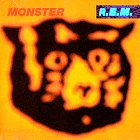 After the tremendous success of Out of Time and Automatic for the People, the members of R.E.M. were determined to, in the words of Peter Buck, put away the dulcimers and make a rock and roll record. The result was Monster, an album that fueled the band’s 1995 arena tour and a metamorphosis in their image but that doesn’t quite meet their high standards.
After the tremendous success of Out of Time and Automatic for the People, the members of R.E.M. were determined to, in the words of Peter Buck, put away the dulcimers and make a rock and roll record. The result was Monster, an album that fueled the band’s 1995 arena tour and a metamorphosis in their image but that doesn’t quite meet their high standards.
The opening track and first single, “What’s the Frequency, Kenneth?,” gets things off to a rather good start, with layers of harder, slightly distorted guitar setting the album’s tone while Michael Stipe sings about the inability to understand a younger generation and the foolishness of trying. (The song also marks the beginnings of the health problems that plagued this album and tour, as Mike Mills began to feel the symptoms of appendicitis toward the end of recording it and soon wound up in surgery.) While the sound isn’t quite like anything the band had done before, the underlying structure isn’t too far removed from previous up-tempo songs, and there’s enough of a melody to support the sonic touches.
The same can’t be said of every song on the album; the second track, “Crush with Eyeliner,” doesn’t seem to go anywhere and ultimately drowns under the feedback wail. The album’s closer, “You,” suffers the same malady. On the other hand, the most powerful song on the album is one of the slowest and least melodic; “Let Me In,” which Stipe wrote after learning of Kurt Cobain’s suicide, contrasts a quiet, mournful lyrical performance with a howling lead guitar played by Mills to very powerful effect. (The live performance of this song was a highlight of the tour as well.)
There are a couple of fast-moving, high-energy songs on the album as well, which are among my favorites. “Star 69” and “King of Comedy” are successful experiments that prove the band can indeed still rock out. “Strange Currencies” takes the basic melody from Automatic‘s “Everybody Hurts” and reworks it to fit the album’s style; like many of the songs on Monster, Stipe’s new lyrics suggest the darker, possessive aspect of relationships. That dark edge, and the more pronounced sexuality of songs like “Tongue” and “I Don’t Sleep, I Dream,” are Monster‘s primary themes.
 In the end, Monster isn’t the attempt to cash in on grunge’s popularity that some critics accused the band of making; it’s a not-always-successful experiment that epitomizes R.E.M.’s determination not to get stuck in a rut. Of course, even failed experiments can yield results, and I’d argue that’s the case with Monster, which helped set the stage for one of the group’s finest works.
In the end, Monster isn’t the attempt to cash in on grunge’s popularity that some critics accused the band of making; it’s a not-always-successful experiment that epitomizes R.E.M.’s determination not to get stuck in a rut. Of course, even failed experiments can yield results, and I’d argue that’s the case with Monster, which helped set the stage for one of the group’s finest works.
- What’s the Frequency, Kenneth? (4:00)
- Crush with Eyeliner (4:38)
- King of Comedy (3:41)
- I Don’t Sleep, I Dream (3:28)
- Star 69 (3:08)
- Strange Currencies (3:53)
- Tongue (4:13)
- Bang and Blame (5:30)
- I Took Your Name (4:03)
- Let Me In (3:28)
- Circus Envy (4:15)
- You (4:54)
Released by: Warner Bros.
Release date: 1994
Total running time: 49:16
R.E.M. – Up
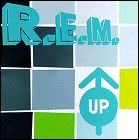 Up was R.E.M.’s first album without Bill Berry, and it was almost their last. The sudden recalibration of creative and professional dynamics that had been established over the course of 17 years was almost too high a hurdle to overcome, and that uncertainty and gloominess certainly makes its way onto these 14 tracks. Filled with drum machines, sound loops and droning effects, it’s not an album that leaps out at you. In truth, my first few times through Up were a difficult process. The musical richness and emotional strength I had come to expect from the band were hard to find.
Up was R.E.M.’s first album without Bill Berry, and it was almost their last. The sudden recalibration of creative and professional dynamics that had been established over the course of 17 years was almost too high a hurdle to overcome, and that uncertainty and gloominess certainly makes its way onto these 14 tracks. Filled with drum machines, sound loops and droning effects, it’s not an album that leaps out at you. In truth, my first few times through Up were a difficult process. The musical richness and emotional strength I had come to expect from the band were hard to find.
With time, I think I was able to put what I was expecting out of my head and listen to what was actually on the record, and gradually my opinion shifted. I still find the opening track, “Airportman,” fairly dull and uninteresting, and I’m less than crazy about number three, “Suspicion.” Song number four, “Hope,” is where things really start to pique my interest. Michael Stipe takes the vocal melody of a Leonard Cohen song and imposes it over a sequence of synthesizer loops, as he sings of someone hoping for something to believe in. Now, I am normally quite reluctant to try to provide any kind of literal interpretation of Stipe’s lyrics outside the context of a song; that way lies madness. But I first heard the lines “And you’re questioning the sciences and you’re questioning religion” at a point in my graduate studies where I was doing exactly that, so this song was quite a useful reference point. I do think that this album features some of Stipe’s strongest lyric writing in the band’s history, even as those lyrics rely heavily on the musical support offered by Mike Mills and Peter Buck. Many of the songs on this album are more direct than usual for R.E.M., and Up includes the full lyrics to every song on the album for the first time, so those who do want to brave the interpretative woods will find a few useful trail markers.
 When Stipe writes a love song, he usually inserts some kind of cynical twist; I haven’t been able to find it in “At My Most Beautiful,” a Beach Boys-inspired song built around Mills’ piano and backup vocals. The momentary sunniness is quickly dispelled with the next track, “The Apologist.” The song’s protagonist is a member of a self-help group who gradually becomes more and more aggressive with his apparent humility and contrition, and the music captures that building tension perfectly. The rest of the album explores that darkness in different guises, such as the nocturnal desk jockey of “Daysleeper,” the drunk “Sad Professor” who hates how he’s wound up, and the criminal defendant who wants to convince a jury that he’s “Diminished.” The darkness is not quite unrelenting; “Walk Unafraid” is a rousing celebration of individuality with all its attendant mistakes, and Stipe takes a moment to ask someone who’s “been sad for a while,” “Why Not Smile?” The closing track, “Falls To Climb,” encapsulates the conflict; Stipe argues that “someone has to take the fall,” and decides, “Why not me?” In making that decision, he finally declares, “I am free.” It’s a fairly triumphant rebirth, and one that signals that R.E.M. is not quite finished yet.
When Stipe writes a love song, he usually inserts some kind of cynical twist; I haven’t been able to find it in “At My Most Beautiful,” a Beach Boys-inspired song built around Mills’ piano and backup vocals. The momentary sunniness is quickly dispelled with the next track, “The Apologist.” The song’s protagonist is a member of a self-help group who gradually becomes more and more aggressive with his apparent humility and contrition, and the music captures that building tension perfectly. The rest of the album explores that darkness in different guises, such as the nocturnal desk jockey of “Daysleeper,” the drunk “Sad Professor” who hates how he’s wound up, and the criminal defendant who wants to convince a jury that he’s “Diminished.” The darkness is not quite unrelenting; “Walk Unafraid” is a rousing celebration of individuality with all its attendant mistakes, and Stipe takes a moment to ask someone who’s “been sad for a while,” “Why Not Smile?” The closing track, “Falls To Climb,” encapsulates the conflict; Stipe argues that “someone has to take the fall,” and decides, “Why not me?” In making that decision, he finally declares, “I am free.” It’s a fairly triumphant rebirth, and one that signals that R.E.M. is not quite finished yet.
- Airportman (4:13)
- Lotus (4:31)
- Suspicion (5:37)
- Hope (5:01)
- At My Most Beautiful (3:35)
- The Apologist (4:29)
- Sad Professor (4:03)
- You’re In The Air (5:23)
- Walk Unafraid (4:33)
- Why Not Smile (4:02)
- Daysleeper (3:39)
- Diminished (6:00)
- Parakeet (4:12)
- Falls To Climb (5:06)
Released by: Warner Bros.
Release date: 1998
Total running time: 64:31
Tree Wave – Cabana+ EP
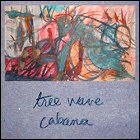 An Austin-based duo, Tree Wave is earning quite a name for itself, as much for its music as how it’s being made. Electronics wiz and musician Paul Slocum has fashioned a cluster of distinctly 80s technology into his own arsenal of instruments: a 386 PC with a dot matrix printer souped up to produce specific pitches, an Atari 2600 running Paul’s custom-programmed music software, and a Commodore 64. On the surface of it, this sounds like an act that’s going to be turning out some very twitchy, blippy music, right? You’ll probably be pleasantly surprised.
An Austin-based duo, Tree Wave is earning quite a name for itself, as much for its music as how it’s being made. Electronics wiz and musician Paul Slocum has fashioned a cluster of distinctly 80s technology into his own arsenal of instruments: a 386 PC with a dot matrix printer souped up to produce specific pitches, an Atari 2600 running Paul’s custom-programmed music software, and a Commodore 64. On the surface of it, this sounds like an act that’s going to be turning out some very twitchy, blippy music, right? You’ll probably be pleasantly surprised.
In fact, Tree Wave comes off sounding like an early new wave band in an age when the songs weren’t written much differently than before, but the real novelty was in how the sounds were made. Vocalist Lauren Gray’s take on the human element in this decidedly electronic brew can range from husky to airy depending on the particular song, and it strikes just the right counterbalance to Slocum’s dense wall of sound. There are occasionally some blippy, 8-bit elements to the backing tracks, but there’s also something unexpectedly full and orchestrated about the sound – unobtrusive synth pads and decent drum sounds keep things afloat, and if you’re shaking your head at the thought of a printer as a musical instrument, listen to the anthemic opening moments of “Sleep” and think again. Slocum has found a great balance between the novelty of how he’s making the music, and the music that’s being played (not to mention that he breaks Tree Wave’s apparent mandate in the opening track, “May Banners”, with some Byrds-esque guitar work). The novelty never takes over for sheer  gimmickry’s sake. “Morning Coffee Hymn” and “Same” are also highlights.
gimmickry’s sake. “Morning Coffee Hymn” and “Same” are also highlights.
Tree Wave is gaining quite a bit of attention from the music community and the media, so hopefully it’ll only be a matter of time the right label takes note and signs them for a full-length album and promotes them with a bit of tender loving care. Mainstream they’re not, but catchy they most definitely are.
- May Banners (3:43)
- Machines Fall Apart (3:06)
- Sleep (2:56)
- Instrumental 1b (4:00)
- Morning Coffee Hymn (3:38)
- Same (3:20)
Released by: Tree Wave
Release date: 2005
Total running time: 23:43
Levinhurst – Perfect Life
 An interestingly retro effort, Perfect Life is a bit of a manifesto for Levinhurst: it aims to bring some ’80s new wave feel back into the present with the help of some modern technology. And Levinhurst does carry the necessary pedigree to accomplish this; leading the trio is Lol Tolhurst, founding member of The Cure, with Cindy Levinson handling vocals and Dayton Borders providing some synth and sequencer wizardry.
An interestingly retro effort, Perfect Life is a bit of a manifesto for Levinhurst: it aims to bring some ’80s new wave feel back into the present with the help of some modern technology. And Levinhurst does carry the necessary pedigree to accomplish this; leading the trio is Lol Tolhurst, founding member of The Cure, with Cindy Levinson handling vocals and Dayton Borders providing some synth and sequencer wizardry.
If I have a gripe with Levinhurst’s debut effort, it lies more with the track sequencing than anything. Kicking off with a brief, atmospheric instrumental, the album really doesn’t properly start until the percolating intro of “Let’s Go” hits, and while it’s a decent song, it’s very repetitive lyrically, and even those lyrics are pretty lightweight compared to many of the other songs; thematically, I understand why “Let’s Go” is where it is, as an invitation to the rest of the album, but it’s one of the album’s weaker songs, so it really undermines that point. “Sorrow” hits next, and it’s immediately clear when I hear it that this should’ve been the lead track (and the lead single, but I’ll return to that point later). It sweeps into a dark, electronic rhythm worthy of early Eurythmics or Depeche Mode, with Levinson providing some of the best vocals on the whole disc. This song is actually what tipped me off to Levinhurst in the first place (when I heard it on Free Zone on WICR, Indianapolis – just a wee plug there).
The excellent vocals and interesting approach to instrumentation carries over into “Sadman”, another excellent track, and “Lost” is a delightful track that has, compositionally speaking, what I’d describe as musical red herrings – the chord and melodic progressions sometimes lead you to places where you would’ve had no reasonable expectation of the song going. Maybe that’s an example of writing stuff cleverly that only other songwriters would pick up on, or maybe it’s an example of writing in that distinctive let’s-break-the-rules-of-how-this-is-done style of the ’80s, but it’s a neat track all the same. A brief instrumental, “Insomniac”, follows, and it smacks just a little bit of early Depeche Mode, and after that comes the perky, swirling, begs-to-be-danced-to “Despair” – seems like a bit of a contradiction, doesn’t it?
The lead single for Perfect Life is “Hope”, and “Hope” is a decent song, but it’s somehow not as catchy as “Sorrow” or even “Let’s Go”; all I can figure is that the band (or the label) wanted something with an upbeat mood coming out of the starting gate. If they wanted something that sounded “up,” even the last song, “More / Mad”, would’ve fit the bill. After checking the credits in the CD booklet, I wonder if I wasn’t picking up on something else: “Hope” alone was recorded in a different studio and put together by a different producer. Something about it is a little “noisier” than some of the other tracks, with heavy distortion  introduced on some of the synth parts, and it just doesn’t seem entirely representative of the sound established on the rest of the album.
introduced on some of the synth parts, and it just doesn’t seem entirely representative of the sound established on the rest of the album.
Perfect Life may not be a perfect album, but it does show great promise for Levinhurst. Hopefully they’ll get a chance to follow up on it.
- Vinti (1:13)
- Let’s Go (3:40)
- Sorrow (3:30)
- Sadman (5:41)
- Lost (4:14)
- Insomniac (1:33)
- Despair (3:48)
- Hope (3:03)
- Behind Me (4:09)
- Perfect Life (1:31)
- More / Mad (7:06)
Released by: Full Contact
Release date: 2004
Total running time: 39:30